The laboratory established by Piotr Widłak PhD, DSc. Since May 2022 the group has been headed by Monika Pietrowska PhD, DSc.
Main research directions
- Application of mass spectrometry to identification and validation of novel proteomic and metabolomic markers of potential importance in the molecular diagnosis of cancer.
- The role of extracellular vesicles in intercellular communication.
- Cellular response to stress and regulation of signal transduction pathways induced by radiation and other DNA damaging agents.
Keywords:
proteomics; metabolomics; mass spectrometry; MALDI imaging; serum proteome; biomarkers; cell signalling; response to stress; regulation of gene expression; ionizing radiation; small extracellular vesicles; oncoimmunology
The Group
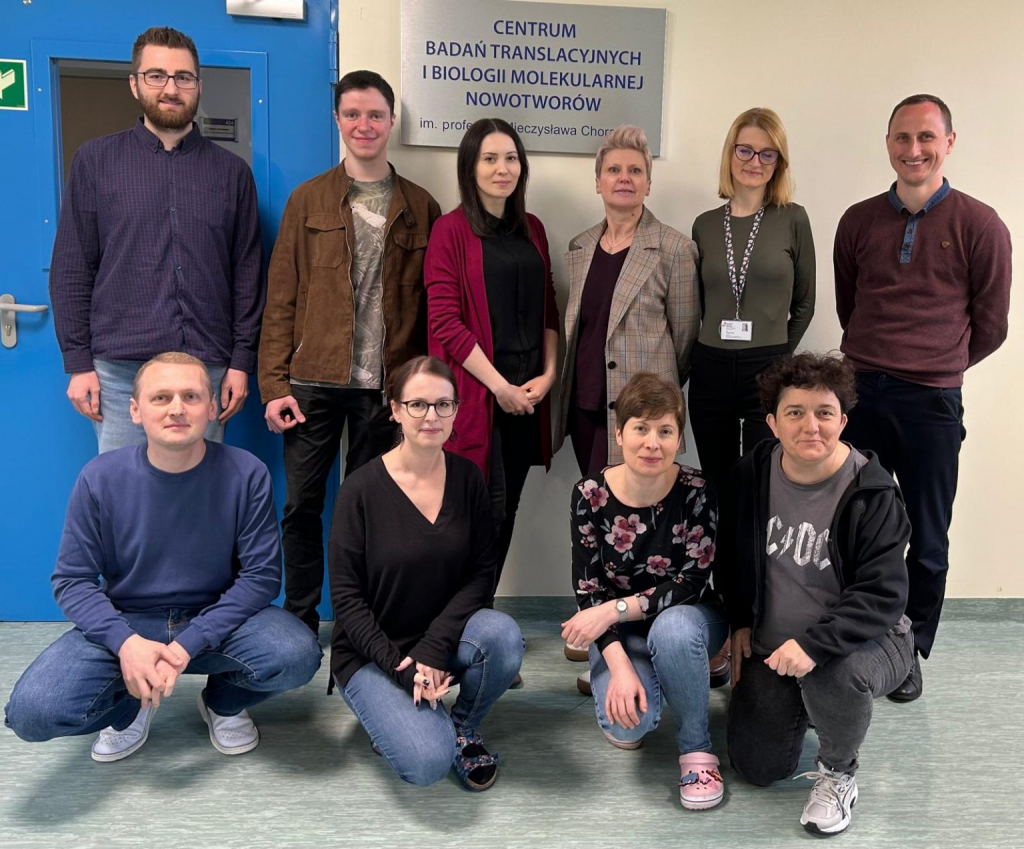
| Monika Pietrowska PhD, DSc | professor | monika.pietrowska@gliwice.nio.gov.pl | +48 32 278 9672 |
| Marta Gawin PhD | assistant professor | marta.gawin@gliwice.nio.gov.pl | +48 32 278 9627 |
| Karol Jelonek PhD | assistant professor | karol.jelonek@gliwice.nio.gov.pl | +48 32 278 9627 |
| Katarzyna Szołtysek PhD | assistant professor | katarzyna.szoltysek@gliwice.nio.gov.pl | St. Jude Children’s Research Hospital, Memphis, USA |
| Daria Kania PhD | assistant | daria.kania@gliwice.nio.gov.pl | +48 32 278 9627 |
| Michalina Gramatyka PhD | assistant | michalina.gramatyka@gliwice.nio.gov.pl | +48 32 278 9628 |
| Mateusz Smolarz PhD | biotechnologist | mateusz.smolarz@gliwice.nio.gov.pl | Academy of Physical Education in Katowice |
| Maciej Ciebiada MSc | PhD student | maciej.ciebiada@gliwice.nio.gov.pl | +48 32 278 9628 |
| Aneta Żebrowska MSc | biologist | aneta.zebrowska@gliwice.nio.gov.pl | +48 32 278 9628 |
| Kinga Karoń MSc | PhD student | kinga.karon@gliwice.nio.gov.pl | +48 32 278 9627 |
| Łukasz Ważny MSc | PhD student | lukasz.wazny@gliwice.nio.gov.pl | +48 32 278 9628 |
Scientific cooperation

THERESA L. WHITESIDE, PhD
UPMC HILLMAN CANCER CENTER, UNIVERSITY OF PITTSBURGH, USA
Webpage:
https://www.immunology.pitt.edu/person/theresa-l-whiteside-phd
https://path.upmc.edu/personnel/Faculty/Whiteside.htm
Phone: +1-(412)624-0096
E-mail: whitesidetl@upmc.edu
Address:
Theresa L. Whiteside, PhD, MDHC
Professor of Pathology, Immunology and Otolaryngology
UPMC Hillman Cancer Center
University of Pittsburgh Cancer Institute
5117 Centre Avenue
Pittsburgh, PA 15213, U.S.A.
Scientific focus:
The Laboratory of Dr. Theresa L Whiteside is located in the Hillman Cancer Center, University of Pittsburgh. Dr. Whiteside is a group leader of a several investigators (staff members and post-doctoral trainees) conducting basic and translational research focused on defining the role of tumor-derived exosomes (TEX) in the promotion of tumor growth. The laboratory has been conducting pre-clinical and clinical research aimed at defining the mechanisms TEX use to suppress functions of immune cells and mediate pro-tumor activities. In collaboration with Prof. Pietrowska’s group in Gliwice, we have been using proteomics to characterize the protein profiles of TEX isolated from plasma of patients with melanoma or head and neck cancer (HNC) and to establish correlations between TEX protein profiles and the ability of TEX to mediate immune suppression and cancer promotion. This collaboration has been highly successful: it allowed us to identify the exosome protein profiles that discriminated melanoma patients from healthy donors and also profiles that discriminated melanoma patients with progressive disease from those who were NED after oncologic therapies. These high impact studies were published in JEV (2021), a premier journal in the exosome field. The studies of TEX continue and are being extended to TEX isolated from plasma of patients with other cancers. We expect that TEX as components of liquid tumor biopsy might be confirmed to serve as biomarkers of cancer progression and outcome after oncological therapies. The collaborative studies with Prof. Pietrowska are currently supported by grants from National Institutes of Health (NIH) and the United States Department of Defense (U.S. DOD).
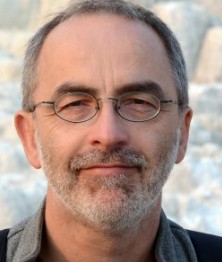
PIOTR WIDŁAK PhD, DSc
CLINICAL RESEARCH SUPPORT CENTRE MEDICAL UNIVERSITY OF GDAŃSK
Phone: +48 58 349 27 67
Webpage: https://clinicalresearch.mug.edu.pl/66586.html
E-mail: piotr.widlak@gumed.edu.pl
Address:
Piotr Widłak PhD, DSc
Clinical Research Support Centre
building no. 9, room 009/0025
Medical University of Gdańsk
ul. M. Skłodowskiej-Curie 3a
80-210 Gdańsk, Poland
Scientific focus: Prof. Widłak’s recent research interests are in clinical applications of proteomics and metabolomics tools.

ANNA DUBROVSKA, PhD
ONCORAY – NATIONAL CENTER FOR RADIATION RESEARCH IN ONCOLOGY, DRESDEN, GERMANY
Webpage:
https://www.oncoray.de/research/biomarkers-for-the-individualized-radiotherapy
Phone: +49 (0) 35 1458 7150
E-mail: anna.dubrovska@oncoray.de
Address:
Prof. Dr. Anna Dubrovska
OncoRay – National Center for Radiation Research in Oncology
Händelallee 28
01309 Dresden, Germany
Scientific focus:
Establishing the clinically relevant molecular biomarkers for prostate cancer and head and neck squamous cell carcinoma treated with radiotherapy;
Developing the targeting strategy toward radioresistant tumor cell populations;
Deciphering the molecular mechanisms explaining the response of cancer stem cells and metastasis-initiating cells to photon and proton radiotherapy.

JADWIGA JABLONSKA, PhD
UNIVERSITY HOSPITAL, ESSEN, GERMANY
Webpage:
https://hno.uk-essen.de/forschung/ag-neutrophil-biology-translational-oncology/
https://www.uni-due.de/zmb/members/jadwiga-jablonska-koch.php
https://www.researchgate.net/profile/Jadwiga_Jablonska
Phone: +49 201 / 723-3190
E-mail: jadwiga.jablonska@uk-essen.de
Twitter: @JablonskaLab
Address:
Priv.-Doz. Dr. rer. nat. Jadwiga Jablonska, PhD
Head Translational Oncology
Department of Otorhinolaryngology
University Hospital Essen
Hufelandstrasse 55
45127 Essen, Germany
Scientific focus:
The group explores neutrophil biology and activity in the context of cancer with the ultimate goal of developing a novel neutrophil-based cancer-immunotherapies.
Neutrophils are the most abundant population of leukocytes circulating in human blood that play a key role in the first defense against microbial infections. These cells possess unique and subtle mechanisms to fight off pathogens. In the past, neutrophils were largely ignored in the cancer research due to their highly specialized functions in anti-microbial immune responses. Nowadays, these cells are recognized for their extreme versatility with regard to function and as important players influencing tumor development.
Neutrophils play essential role in inflammation-driven tumorigenesis, therefore representing an independent prognostic marker in a broad variety of neoplasias. Depending on the cytokine milieu, tumor infiltrating neutrophils (TANs) appear to have diverse phenotypes i.e. tumor promoting (N2) or tumor-inhibiting (N1). Importantly, alterations in neutrophil activity could be responsible for the changes in the host predisposition for tumor development, since these cells have a capacity to influence tumor angiogenesis, growth and metastasis.
The research group focuses on the neutrophil-dependent immunoregulatory mechanisms that are responsible for the cancerogenesis in mice and human. They study molecular mechanisms involved in neutrophil polarization, mobilization and activation, but also complex interaction between regulatory myeloid cells during inflammation. The group’s ultimate aim is to identify effective therapeutic approaches to target tumor- promoting myeloid cell functions.
Moreover, the group is interested in overall neutrophil biology, i.e. development, differentiation, activation, migration and responses to various inflammatory stimuli in disease. They analyze the role of multiple cytokines and growth factors in the regulation of emergency myelopoiesis, factors involved in neutrophil homing and the correlation between neutrophil activation and the outcome of disease. Interactions between neutrophils and other myeloid cells are evaluated in cancer, but also during sterile inflammation and infection.

MARIE-NICOLE THEODORAKI, PhD, MD
UNIVERSITY HOSPITAL OF ULM, GERMANY
E-mail: marie-nicole.theodoraki@uniklinik-ulm.de
Address:
prof. Marie-Nicole Theodoraki
Universitätsklinikum Ulm
Klinik für Hals-Nasen-Ohrenheilkunde und Kopf- und Halschirurgie
Frauensteige 12
89075 Ulm, Germany
Scientific focus:
Head and neck cancer is a malignant tumor characterized by intense production of immunosuppressive factors in the tumor microenvironment. Prof Theodoraki’s team is investigating how exosomes released from tumor cells inhibit immune cell function, and how to modulate the immunosuppressive tumor microenvironment. Exosomes are virus-sized vesicles that are produced by each cell and provide an efficient pathway for intercellular communication. They contain numerous pieces of information from the cell from which they are released (DNA, RNA, proteins) and can transmit them to the recipient cell. Previous studies have shown that head and neck cancer cells release relatively more exosomes than other cells and transmit a wide range of information to immune cells, either inhibiting or activating them. The team is also investigating the possibility of using exosomes as liquid biomarkers in assessing disease progression and treatment efficacy.

NILS LUDWIG, PhD, MD
UNIVERSITY HOSPITAL REGENSBURG, GERMANY
Webpage:
https://www.ukr.de/en/oral-and-maxillofacial-surgery
https://www.researchgate.net/profile/Nils-Ludwig
E-mail: Nils.Ludwig@klinik.uni-regensburg.de
Scientific focus:
Research conducted by the group focuses on angiogenesis and the modulation of the tumor microenvironment by small extracellular vesicles, also known as exosomes. The rapidly increasing number of publications on exosomes and their role in tumor progression motivates to get a better understanding of the mechanisms underlying the exosome-blood vessel cross-talk which may lead to improvements in current diagnosis, prognosis and treatment of cancer. In collaboration with Dr. Monika Pietrowska the group analyzed the proteomic cargo components of tumor-derived exosomes in terms of their pro-angiogenic contents.
Laboratory equipment
Q Exactive Plus mass spectrometer with a quadrupole and an Orbitrap mass analyzers coupled with UltiMate 3000 RSLC liquid chromatograph (both from Thermo Scientific) is a high resolution mass spectrometer which can be applied to both proteomic and lipidomic experiments.

ultrafleXtreme MALDI-TOF/TOF mass spectrometer (Bruker Daltonics) enables visualization of spatial distribution of proteins, peptides, pharmaceuticals and their metabolites, as well as biomarkers and other compounds in thin sections of human, animal and plant tissues.
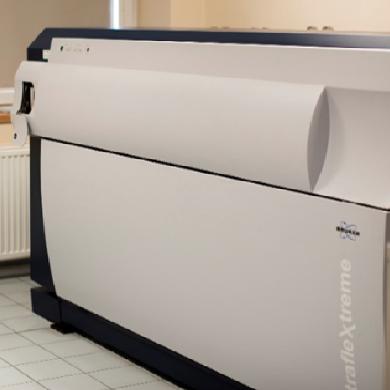
Elyra 7 (Zeiss): a system for super-resolution microscopy utilizing SIM2 technology.

Barocycler 2320 EXT (Pressure BioSciences, Inc.): a sample preparation system utilizing the pressure cycling technology (PCT).

SunCollect (SunChrom GmbH): a system which can be used for LC fraction collection (also on a MALDI target plate), as well as for spraying liquids using a pneumatic nebulizer.
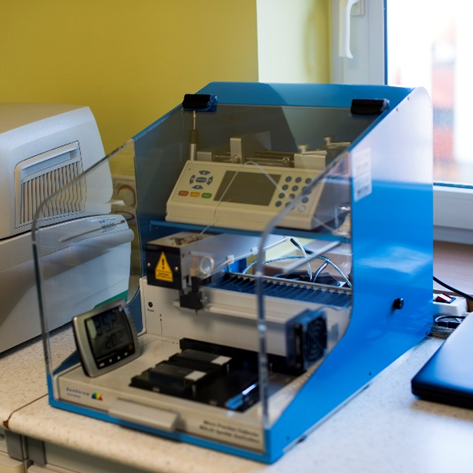
SunDigest (SunChrom GmbH): a humid chamber for incubation of tissue preparations on microscopic glass slides.

Savant™ SPD120 SpeedVac™ (Thermo Fisher Scientific): vacuum concentrator for evaporation of non-aggressive solvents.
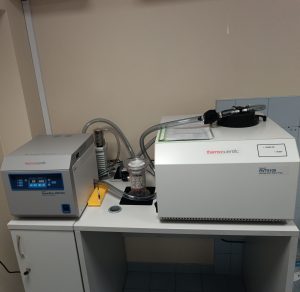
ZetaView Twin (Particle Metrix): a system for measurements of size and concentration of nanoparticles, with co-localization function.
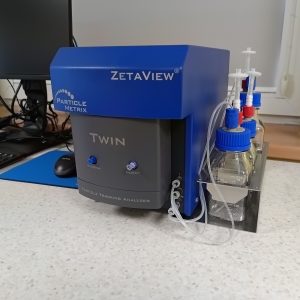
Scientific Papers
2024
Fochtman D, Marczak L, Pietrowska M, Wojakowska A (2024): Challenges of MS-based small extracellular vesicles proteomics. J Extracell Vesicles. 13(12):e70020. doi: 10.1002/jev2.70020.
https://pubmed.ncbi.nlm.nih.gov/39692094/
Ważny Ł, Whiteside TL, Pietrowska M (2024): Oncoviral Infections and Small Extracellular Vesicles. Viruses. 16(8):1291. doi: 10.3390/v16081291.
https://pubmed.ncbi.nlm.nih.gov/39205265/
Kieronska-Rudek A, Kij A, Bar A, Kurpinska A, Mohaissen T, Grosicki M, Stojak M, Sternak M, Buczek E, Proniewski B, Kuś K, Suraj-Prazmowska J, Panek A, Pietrowska M, Zapotoczny S, Shanahan CM, Szabo C, Chlopicki S (2024): Phylloquinone improves endothelial function, inhibits cellular senescence, and vascular inflammation. Geroscience. 46(5):4909-4935. doi: 10.1007/s11357-024-01225-w.
https://pubmed.ncbi.nlm.nih.gov/38980631/
Mrowiec K, Debik J, Jelonek K, Kurczyk A, Ponge L, Wilk A, Krzempek M, Giskeødegård GF, Bathen TF, Widłak P (2024): Profiling of serum metabolome of breast cancer: multi-cancer features discriminate between healthy women and patients with breast cancer. Front Oncol. 14:1377373. doi:10.3389/fonc.2024.1377373.
https://pubmed.ncbi.nlm.nih.gov/38646441/
Łysek-Gładysińska M, Wieczorek A, Walaszczyk A, Jelonek K, Pietrowska M, Widłak P, Kulik R, Gabryś D (2024): Late Effects of Ionizing Radiation on the Ultrastructure of Hepatocytes and Activity of Lysosomal Enzymes in Mouse Liver Irradiated In Vivo. Metabolites. 14(4):212. doi:10.3390/metabo14040212.
https://pubmed.ncbi.nlm.nih.gov/38668340/
Hus KK, Buczkowicz J, Pietrowska M, Petrilla V, Petrillová M, Legáth J, Litschka-Koen T, Bocian A (2024): Venom diversity in Naja mossambica: Insights from proteomic and immunochemical analyses reveal intraspecific differences. PLoS Negl Trop Dis. 18(4):e0012057. doi: 10.1371/journal.pntd.0012057.
https://pubmed.ncbi.nlm.nih.gov/38557658/
Łasut-Szyszka B, Gdowicz-Kłosok A, Małachowska B, Krześniak M, Będzińska A, Gawin M, Pietrowska M, Rusin M (2024): Transcriptomic and proteomic study of cancer cell lines exposed to actinomycin D and nutlin-3a reveals numerous, novel candidates for p53-regulated genes. Chem Biol Interact. 110946. doi: 10.1016/j.cbi.2024.110946.
https://pubmed.ncbi.nlm.nih.gov/38460933/
Wojakowska A, Marczak L, Zeman M, Chekan M, Zembala-Nożyńska E, Polanski K, Strugała A, Widlak P, Pietrowska M (2024): Proteomic and metabolomic signatures of rectal tumor discriminate patients with different responses to preoperative radiotherapy. Front Oncol. 14:1323961. doi: 10.3389/fonc.2024.1323961.
https://pubmed.ncbi.nlm.nih.gov/38410100/
Welsh JA, Goberdhan DCI, O’Driscoll L, Buzas EI, Blenkiron C, Bussolati B, …, Pietrowska M, …, Théry C, Witwer KW (2024): Minimal information for studies of extracellular vesicles (MISEV2023): From basic to advanced approaches. J Extracell Vesicles 13(2):e12404. doi: 10.1002/jev2.12404.
https://pubmed.ncbi.nlm.nih.gov/38326288/
Korecka K, Gawin M, Pastuszka A, Partyka M, Koszutski T, Pietrowska M, Hyla-Klekot L (2024): Proteomics of urinary small extracellular vesicles in early diagnosis of kidney diseases in children-expectations and limitations. Proteomics e2300168. doi: 10.1002/pmic.202300168.
https://pubmed.ncbi.nlm.nih.gov/38213025/
Zyla J, Marczyk M, Prazuch W, Sitkiewicz M, Durawa A, Jelitto M, Dziadziuszko K, Jelonek K, Kurczyk A, Szurowska E, Rzyman W, Widłak P, Polanska J (2024): Combining Low-Dose Computer-Tomography-Based Radiomics and Serum Metabolomics for Diagnosis of Malignant Nodules in Participants of Lung Cancer Screening Studies. Biomolecules 14(1):44. doi: 10.3390/biom14010044.
https://pubmed.ncbi.nlm.nih.gov/38254644/
2023
Rasouli M, Blair H, Troester S, Szoltysek K, Cameron R, Ashtiani M, Krippner-Heidenreich A, Grebien F, McGeehan G, Zwaan CM, Heidenreich O (2023): The MLL-Menin Interaction is a Therapeutic Vulnerability in NUP98-rearranged AML. Hemasphere 7(8):e935. doi: 10.1097/HS9.0000000000000935.
https://pubmed.ncbi.nlm.nih.gov/37520776/
Jelonek K, Mrowiec K, Gabryś D, Widłak P (2023): The Metabolic Footprint of Systemic Effects in the Blood Caused by Radiotherapy and Inflammatory Conditions: A Systematic Review. Metabolites 13(9):1000. doi: 10.3390/metabo13091000.
https://pubmed.ncbi.nlm.nih.gov/37755280/
Skoczylas Ł, Gawin M, Fochtman D, Widłak P, Whiteside TL, Pietrowska M. (2023): Immune capture and protein profiling of small extracellular vesicles from human plasma. Proteomics 15:e2300180. doi: 10.1002/pmic.202300180.
https://pubmed.ncbi.nlm.nih.gov/37713108/
Mrowiec K, Kurczyk A, Jelonek K, Debik J, Giskeødegård GF, Bathen TF, Widłak P (2023): Association of serum metabolome profile with the risk of breast cancer in participants of the HUNT2 study. Front Oncol. 13:1116806. doi: 10.3389/fonc.2023.1116806.
https://pubmed.ncbi.nlm.nih.gov/37007110/
2022
Tirtakusuma R, Szoltysek K, Milne P, Grinev VV, Ptasinska A, Chin PS, Meyer C, Nakjang S, Hehir-Kwa JY, Williamson D, Cauchy P, Keane P, Assi SA, Ashtiani M, Kellaway SG, Imperato MR, Vogiatzi F, Schweighart EK, Lin S, Wunderlich M, Stutterheim J, Komkov A, Zerkalenkova E, Evans P, McNeill H, Elder A, Martinez-Soria N, Fordham SE, Shi Y, Russell LJ, Pal D, Smith A, Kingsbury Z, Becq J, Eckert C, Haas OA, Carey P, Bailey S, Skinner R, Miakova N, Collin M, Bigley V, Haniffa M, Marschalek R, Harrison CJ, Cargo CA, Schewe D, Olshanskaya Y, Thirman MJ, Cockerill PN, Mulloy JC, Blair HJ, Vormoor J, Allan JM, Bonifer C, Heidenreich O, Bomken S (2022): Epigenetic regulator genes direct lineage switching in MLL/AF4 leukemia. Blood 140(17):1875-1890. doi: 10.1182/blood.2021015036.
https://pubmed.ncbi.nlm.nih.gov/35839448/
Kurczyk A, Gawin M, Paul P, Chmielik E, Rutkowski T, Pietrowska M, Widłak P (2022): Prognostic Value of Molecular Intratumor Heterogeneity in Primary Oral Cancer and Its Lymph Node Metastases Assessed by Mass Spectrometry Imaging. Molecules 27(17):5458. doi: 10.3390/molecules27175458.
https://pubmed.ncbi.nlm.nih.gov/36080226/
Ludwig N, Yerneni SS, Azambuja JH, Pietrowska M, Widłak P, Hinck CS, Głuszko A, Szczepański MJ, Kärmer T, Kallinger I, Schulz D, Bauer RJ, Spanier G, Spoerl S, Meier JK, Ettl T, Razzo BM, Reichert TE, Hinck AP, Whiteside TL (2022): TGFβ+ small extracellular vesicles from head and neck squamous cell carcinoma cells reprogram macrophages towards a pro-angiogenic phenotype. J Extracell Vesicles. 11(12):e12294. doi: 10.1002/jev2.12294.
https://pubmed.ncbi.nlm.nih.gov/36537293/
Zając G, Rusin M, Łasut-Szyszka B, Puszyński K, Widłak P (2022): Activation of the atypical NF-κB pathway induced by ionizing radiation is not affected by the p53 status. Acta Biochim Pol. 69(1):205-210. doi: 10.18388/abp.2020_5942.
https://pubmed.ncbi.nlm.nih.gov/35130377/
Zebrowska A, Jelonek K, Mondal S, Gawin M, Mrowiec K, Widłak P, Whiteside T, Pietrowska M (2022): Proteomic and Metabolomic Profiles of T Cell-Derived Exosomes Isolated from Human Plasma. Cells;11(12):1965. doi: 10.3390/cells11121965.
https://pubmed.ncbi.nlm.nih.gov/35741093/
Strybel U, Marczak L, Zeman M, Polanski K, Mielańczyk Ł, Klymenko O, Samelak-Czajka A, Jackowiak P, Smolarz M, Chekan M, Zembala-Nożyńska E, Widlak P, Pietrowska M, Wojakowska A (2022): Molecular Composition of Serum Exosomes Could Discriminate Rectal Cancer Patients with Different Responses to Neoadjuvant Radiotherapy. Cancers (Basel) 14(4):993. doi: 10.3390/cancers14040993.
https://pubmed.ncbi.nlm.nih.gov/35205741/
Smolarz M, Skoczylas Ł, Gawin M, Krzyżowska M, Pietrowska M, Widłak P (2022): Radiation-Induced Bystander Effect Mediated by Exosomes Involves the Replication Stress in Recipient Cells. Int J Mol Sci. 10;23(8):4169. doi: 10.3390/ijms23084169.
https://pubmed.ncbi.nlm.nih.gov/35456987/
2021
Ciardullo C, Szoltysek K, Zhou P, Pietrowska M, Marczak L, Willmore E, Enshaei A, Walaszczyk A, Ho JY, Rand V, Marshall S, Hall AG, Harrison CJ, Soundararajan M, Eswaran J (2021): Low BACH2 Expression Predicts Adverse Outcome in Chronic Lymphocytic Leukaemia. Cancers (Basel) 14(1):23. doi: 10.3390/cancers14010023.
https://pubmed.ncbi.nlm.nih.gov/35008187/
Jelonek K, Krzywon A, Papaj K, Polanowski P, Szczepanik K, Skladowski K, Widlak P (2021): Dose-dependence of radiotherapy-induced changes in serum levels of choline-containing phospholipids; the importance of lower doses delivered to large volumes of normal tissues. Strahlenther Onkol. 197(10):926-934. doi: 10.1007/s00066-021-01802-4.
https://pubmed.ncbi.nlm.nih.gov/34185114/
Widłak P, Jelonek K, Kurczyk A, Żyła J, Sitkiewicz M, Bottoni E, Veronesi G, Polańska J, Rzyman W (2021): Serum Metabolite Profiles in Participants of Lung Cancer Screening Study; Comparison of Two Independent Cohorts. Cancers 13(11):2714.
https://pubmed.ncbi.nlm.nih.gov/34072693/
Smolarz M, Kurczyk A, Jelonek K, Żyła J, Mielańczyk Ł, Sitkiewicz M, Pietrowska M, Polańska J, Rzyman W, Widłak P (2021): The Lipid Composition of Serum-Derived Small Extracellular Vesicles in Participants of a Lung Cancer Screening Study. Cancers 13(14):3414.
https://pubmed.ncbi.nlm.nih.gov/34298629/
Smolarz M, Widlak P (2021): Serum Exosomes and Their miRNA Load-A Potential Biomarker of Lung Cancer. Cancers. 2021 Mar 18;13(6):1373. doi: 10.3390/cancers13061373.
https://pubmed.ncbi.nlm.nih.gov/33803617/
Pietrowska M, Zebrowska A, Gawin M, Marczak L, Sharma P, Mondal S, Mika J, Polańska J, Ferrone S, Kirkwood JM, Widlak P, Whiteside TL (2021): Proteomic profile of melanoma cell-derived small extracellular vesicles in patients’ plasma: a potential correlate of melanoma progression. J Extracell Vesicles 10:e12063.
https://pubmed.ncbi.nlm.nih.gov/33613873/
2020
Szoltysek K, Ciardullo C, Zhou P, Walaszczyk A, Willmore E, Rand V, Marshall S, Hall A, J Harrison C, Eswaran J, Soundararajan M (2020): DAP Kinase-Related Apoptosis-Inducing Protein Kinase 2 (DRAK2) Is a Key Regulator and Molecular Marker in Chronic Lymphocytic Leukemia. Int J Mol Sci 21(20):7663. doi: 10.3390/ijms21207663.
https://pubmed.ncbi.nlm.nih.gov/33081245/
Wojakowska A, Zebrowska A, Skowronek A, Rutkowski T, Polanski K, Widlak P, Marczak L, Pietrowska M (2020): Metabolic profiles of whole serum and serum-derived exosomes are different in head and neck cancer patients treated by radiotherapy. Pers Med. 10(4):229, doi: 10.3390/jpm10040229.
https://pubmed.ncbi.nlm.nih.gov/33203021/
Kurczyk A, Gawin M, Chekan M, Wilk A, Łakomiec K, Mrukwa G, Frątczak K, Polanska J, Fujarewicz K, Pietrowska M, Widlak P (2020): Classification of Thyroid Tumors Based on Mass Spectrometry Imaging of Tissue Microarrays; a Single-Pixel Approach. Int J Mol Sci. 2020; 21: 6289.
https://pubmed.ncbi.nlm.nih.gov/32878024/
Wojakowska A, Pietrowska M, Widlak P, Dobrowolski D, Wylęgała E, Tarnawska D (2020): Metabolomic Signature Discriminates Normal Human Cornea from Keratoconus-A Pilot GC/MS Study. Molecules 25: 2933.
https://pubmed.ncbi.nlm.nih.gov/32630577/
Jelonek K, Krzywon A, Jablonska P, Slominska EM, Smolenski RT, Polanska J, Rutkowski T, Mrochem-Kwarciak J, Skladowski K, Widlak P (2020): Systemic Effects of Radiotherapy and Concurrent Chemo-Radiotherapy in Head and Neck Cancer Patients-Comparison of Serum Metabolome Profiles. Metabolites 10: E60.
https://pubmed.ncbi.nlm.nih.gov/32046123/
Bocian A, Ciszkowicz E, Hus KK, Buczkowicz J, Lecka-Szlachta K, Pietrowska M, Petrilla V, Petrillova M, Legáth Ľ, Legáth J (2020): Antimicrobial Activity of Protein Fraction from Naja ashei Venom Against Staphylococcus epidermidis. Molecules 25: 293.
https://pubmed.ncbi.nlm.nih.gov/31936872/
Gadher SJ, Widlak P, Kovarova H (2020): Power of Proteomics and Progress in Precision Medicine – 13th Central and Eastern European Proteomic Conference (CEEPC), Ustroń, Poland. Expert Rev Proteomics 17: 335-40.
https://pubmed.ncbi.nlm.nih.gov/32510255/
Wilk A, Gawin M, Frątczak K, Widłak P, Fujarewicz K. On Stability of Feature Selection Based on MALDI Mass Spectrometry Imaging Data and Simulated Biopsy. In: Korbicz J., Maniewski R., Patan K., Kowal M. (eds) Current Trends in Biomedical Engineering and Bioimages Analysis. PCBEE 2019. Advances in Intelligent Systems and Computing, 2020; 1033:82-93.
https://link.springer.com/chapter/10.1007/978-3-030-29885-2_8
Abramowicz A, Łabaj W, Mika J, Szołtysek K, Ślęzak-Prochazka I, Mielańczyk Ł, Story MD, Pietrowska M, Polański A, Widłak P (2020): MicroRNA profile of exosomes and parental cells is differently affected by ionizing radiation. Radiat Res. 194: 133-42.
https://pubmed.ncbi.nlm.nih.gov/32383628/
Żebrowska A, Widlak P, Whiteside T, Pietrowska M (2020): Signaling of Tumor-Derived sEV Impacts Melanoma Progression. Int J Mol Sci. 21: E5066.
https://pubmed.ncbi.nlm.nih.gov/32709086/
Abramowicz A, Story MD (2020): The Long and Short of It: The Emerging Roles of Non-Coding RNA in Small Extracellular Vesicles. Cancers 12(6):1445.
https://pubmed.ncbi.nlm.nih.gov/32498257/
Janus P, Mrowiec K, Vydra N, Widłak P, Toma-Jonik A, Korfanty J, Smolarczyk R, Widłak W (2020): PHLDA1 does not contribute directly to heat shock-induced apoptosis of spermatocytes. Int J Mol Sci. 21: 267.
https://www.ncbi.nlm.nih.gov/pubmed/31906015
2019
Gawin M, Kurczyk A, Stobiecka E, Frątczak K, Polańska J, Pietrowska M, Widłak P (2019): Molecular Heterogeneity of Papillary Thyroid Cancer: Comparison of Primary Tumors and Synchronous Metastases in Regional Lymph Nodes by Mass Spectrometry Imaging. Endocr Pathol. 30: 250-62.
https://www.ncbi.nlm.nih.gov/pubmed/31664609
Bednarczyk K, Gawin M, Chekan M, Kurczyk A, Mrukwa G, Pietrowska M, Polanska J, Widlak P (2019): Discrimination of normal oral mucosa from oral cancer by mass spectrometry imaging of proteins and lipids. J Mol Histol. 50: 1-10.
https://www.ncbi.nlm.nih.gov/pubmed/30390197
Pietrowska M, Wlosowicz A, Gawin M, Widlak P (2019): MS-Based Proteomic Analysis of Serum and Plasma: Problem of High Abundant Components and Lights and Shadows of Albumin Removal. Adv Exp Med Biol. 1073: 57-76.
https://www.ncbi.nlm.nih.gov/pubmed/31236839
Abramowicz A, Wojakowska A, Marczak L, Lysek-Gladysinska M, Smolarz M, Story MD, Polanska J, Widlak P, Pietrowska M (2019): Ionizing radiation affects the composition of the proteome of extracellular vesicles released by head-and-neck cancer cells in vitro. J Radiat Res. 60: 289-97.
https://www.ncbi.nlm.nih.gov/pubmed/30805606
Ludwig S, Marczak L, Sharma P, Abramowicz A, Gawin M, Widlak P, Whiteside TL, Pietrowska M (2019): Proteomes of exosomes from HPV(+) or HPV(-) head and neck cancer cells: differential enrichment in immunoregulatory proteins. OncoImmunology 8: e1593808.
https://www.ncbi.nlm.nih.gov/pubmed/31143515
Smolarz M, Pietrowska M, Matysiak N, Mielańczyk Ł, Widłak P (2019): Proteome Profiling of Exosomes Purified from a Small Amount of Human Serum: The Problem of Co-Purified Serum Components. Proteomes 7: E18.
https://www.ncbi.nlm.nih.gov/pubmed/31035355
Abramowicz A, Widłak P, Pietrowska M (2019): Different Types of Cellular Stress Affect the Proteome Composition of Small Extracellular Vesicles: A Mini Review. Proteomes 7: E23.
https://www.ncbi.nlm.nih.gov/pubmed/31126168
Zebrowska A, Skowronek A, Wojakowska A, Widlak P, Pietrowska M (2019): Metabolome of Exosomes: Focus on Vesicles Released by Cancer Cells and Present in Human Body Fluids. Int J Mol Sci. 20: E3461.
https://www.ncbi.nlm.nih.gov/pubmed/31337156
Balázs K, Kis E, Badie C, Bogdándi EN, Candéias S, Garcia LC, Dominczyk I, Frey B, Gaipl U, Jurányi Z, Kocsis ZS, Rutten EA, Sáfrány G, Widlak P, Lumniczky K (2019): Radiotherapy-Induced Changes in the Systemic Immune and Inflammation Parameters of Head and Neck Cancer Patients. Cancers (Basel) 11: E1324.
https://www.ncbi.nlm.nih.gov/pubmed/31500214
2018
Jelonek K, Widłak P (2018): Metabolome-based biomarkers: their potential role in the early detection of lung cancer. Contemp Oncol ( 22: 135-40.
https://www.ncbi.nlm.nih.gov/pubmed/30455584
Wojakowska A, Cole LM, Chekan M, Bednarczyk K, Maksymiak M, Oczko-Wojciechowska M, Jarząb B, Clench MR, Polańska J, Pietrowska M, Widlak P (2018): Discrimination of papillary thyroid cancer from non-cancerous thyroid tissue based on lipid profiling by mass spectrometry imaging. Endokrynol Pol. 69: 2-8.
https://www.ncbi.nlm.nih.gov/pubmed/29492952
Polanski A, Marczyk M, Pietrowska M, Widlak P, Polanska J (2018): Initializing the EM algorithm for univariate Gaussian, multi-component, heteroscedastic mixture models by dynamic programming partitions. Int J Comput Methods 15: e1850012.
https://www.worldscientific.com/doi/10.1142/S0219876218500123
Abramowicz A, Marczak L, Wojakowska A, Zapotoczny S, Whiteside TL, Widlak P, Pietrowska M (2018): Harmonization of exosome isolation from culture supernatants for optimized proteomics analysis. PLoS One 13: e0205496.
https://www.ncbi.nlm.nih.gov/pubmed/30379855
Szołtysek K, Janus P, Zając G, Stokowy T, Walaszczyk A, Widłak W, Wojtaś B, Gielniewski B, Cockell S, Perkins ND, Kimmel M, Widlak P (2018): RRAD, IL4I1, CDKN1A, and SERPINE1 genes are potentially co-regulated by NF-κB and p53 transcription factors in cells exposed to high doses of ionizing radiation. BMC Genomics. 19: 813.
https://www.ncbi.nlm.nih.gov/pubmed/30419821
Janus P, Szołtysek K, Zając G, Stokowy T, Walaszczyk A, Widłak W, Wojtaś B, Gielniewski B, Iwanaszko M, Braun R, Cockell S, Perkins ND, Kimmel M, Widlak P (2018): Pro-inflammatory cytokine and high doses of ionizing radiation have similar effects on the expression of NF-kappaB-dependent genes. Cell Signal. 46: 23-31.
https://www.ncbi.nlm.nih.gov/pubmed/29476964
Cruz-Garcia L, O’Brien G, Donovan E, Gothard L, Boyle S, Laval A, Testard I, Ponge L, Woźniak G, Miszczyk L, Candéias SM, Ainsbury E, Widlak P, Somaiah N, Badie C (2018): Influence of Confounding Factors on Radiation Dose Estimation Using In Vivo Validated Transcriptional Biomarkers. Health Phys. 115: 90-101.
https://www.ncbi.nlm.nih.gov/pubmed/29787434
Wieczorek A, Lysek-Gladysinska M, Walaszczyk A, Jelonek K, Smolarz M, Pietrowska M, Gabrys D, Kulik R, Widlak P (2018):Changes in activity and structure of lysosomes from liver of mouse irradiated in vivo. Int J Radiat Biol. 94: 443-453.
https://www.ncbi.nlm.nih.gov/pubmed/29611442
Walaszczyk A, Szołtysek K, Jelonek K, Polańska J, Dörr W, Haagen J, Widłak P, Gabryś D (2018): Heart irradiation reduces microvascular density and accumulation of HSPA1 in mice. Strahlenther Onkol. 194: 235-42.
https://www.ncbi.nlm.nih.gov/pubmed/29063166
Lysek-Gladysinska M, Wieczorek A, Walaszczyk A, Jelonek K, Jozwik A, Pietrowska M, Dörr W, Gabrys D, Widlak P (2018): Long-term effects of low-dose mouse liver irradiation involve ultrastructural and biochemical changes in hepatocytes that depend on lipid metabolism. Radiat Environ Biophys. 57: 123-32.
https://www.ncbi.nlm.nih.gov/pubmed/29470638
O’Brien G, Cruz-Garcia L, Majewski M, Grepl J, Abend M, Port M, Tichý A, Sirak I, Malkova A, Donovan E, Gothard L, Boyle S, Somaiah N, Ainsbury E, Ponge L, Slosarek K, Miszczyk L, Widlak P, Green E, Patel N, Kudari M, Gleeson F, Vinnikov V, Starenkiy V, Artiukh S, Vasyliev L, Zaman A, Badie C (2018): FDXR is a biomarker of radiation exposure in vivo. Sci Rep. 8: 684.
https://www.ncbi.nlm.nih.gov/pubmed/29330481
Korfanty J, Stokowy T, Chadalski M, Toma-Jonik A, Vydra N, Widłak P, Wojtaś B, Gielniewski B, Widlak W (2018): SPEN protein expression and interactions with chromatin in mouse testicular cells. Reproduction. 156: 195-206.
https://www.ncbi.nlm.nih.gov/pubmed/29880719
2017
Gawin M, Wojakowska A, Pietrowska M, Marczak Ł, Chekan M, Jelonek K, Lange D, Jaksik R, Gruca A, Widłak P (2017): Proteome profiles of different types of thyroid cancers. Mol Cell Endocrinol. 472: 68-79.
https://www.ncbi.nlm.nih.gov/pubmed/29183805
Pietrowska M, Diehl HC, Mrukwa G, Kalinowska-Herok M, Gawin M, Chekan M, Elm J, Drazek G, Krawczyk A, Lange D, Meyer HE, Polanska J, Henkel C, Widlak P (2017): Molecular profiles of thyroid cancer subtypes: Classification based on features of tissue revealed by mass spectrometry imaging. Biochim Biophys Acta. 1865: 837-45.
https://www.ncbi.nlm.nih.gov/pubmed/27760391
Roś-Mazurczyk M, Wojakowska A, Marczak Ł, Polański K, Pietrowska M, Jelonek K, Domińczyk I, Hajduk A, Rutkowski T, Składowski K, Widłak P (2017): Ionizing radiation affects profile of serum metabolites: increased level of 3-hydroxybutyric acid in serum of cancer patients treated with radiotherapy. Acta Biochim Pol. 64: 189-93.
https://www.ncbi.nlm.nih.gov/pubmed/27815965
Jelonek K, Pietrowska M, Widlak P (2017): Systemic effects of ionizing radiation at the proteome and metabolome levels in the blood of cancer patients treated with radiotherapy: the influence of inflammation and radiation toxicity. Int J Radiat Biol. 93: 683-96.
https://www.ncbi.nlm.nih.gov/pubmed/28281355
Roś-Mazurczyk M, Jelonek K, Marczyk M, Binczyk F, Pietrowska M, Polanska J, Dziadziuszko R, Jassem J, Rzyman W, Widlak P (2017): Serum lipid profile discriminates patients with early lung cancer from healthy controls. Lung Cancer 112: 69-74.
https://www.ncbi.nlm.nih.gov/pubmed/29191603
Roś-Mazurczyk M, Wojakowska A, Marczak Ł, Polański K, Pietrowska M, Polanska J, Dziadziuszko R, Jassem J, Rzyman W, Widlak P (2017): Panel of serum metabolites discriminates cancer patients and healthy participants of lung cancer screening – a pilot study. Acta Biochim Pol. 64: 513-8.
https://www.ncbi.nlm.nih.gov/pubmed/28803255
Walaszczyk A, Pietrowska M, Wojakowska A, Abramowicz A, Chmura A, Masłyk B, Rodziewicz P, Polańska J, Behrendt K, Nowicka E, Tarnawski R, Widłak P (2017): Therapy-related changes in serum proteome patterns of early stage breast cancer patients with different outcome. Protein Pept Lett. 24: 37-45.
https://pubmed.ncbi.nlm.nih.gov/29366405/
Pietrowska M, Funk S, Gawin M, Marczak Ł, Abramowicz A, Widłak P, Whiteside T (2017): Isolation of exosomes for the purpose of protein cargo analysis with the use of mass spectrometry. Methods Mol Biol. 1654: 291-307.
https://www.ncbi.nlm.nih.gov/pubmed/28986800
Szoltysek K, Walaszczyk A, Janus P, Kimmel M, Widlak P (2017): Irradiation with UV-C inhibits TNF-α-dependent activation of the NF-κB pathway in a mechanism potentially mediated by reactive oxygen species. Genes Cells. 22: 45-58.
https://www.ncbi.nlm.nih.gov/pubmed/27976481
2016
Roś-Mazurczyk M, Jelonek K, Pietrowska M, Zagdański A, Suchwałko A, Jastrząb T, Polańska J, Chawińska E, Majewski W, Domińczyk I, Rutkowski T, Miszczyk L, Składowski K, Widłak P (2016): Radiotherapy-induced changes in serum lipid profile of patients with prostate or head and neck cancer. J J Rad Oncol. 3(2): 030.
Widlak P, Pietrowska M, Polanska J, Marczyk M, Ros-Mazurczyk M, Dziadziuszko R, Jassem J, Rzyman W (2016): Serum mass profile signature as a biomarker of early lung cancer. Lung Cancer 99: 46-52.
https://www.ncbi.nlm.nih.gov/pubmed/27565913
Pietrowska M, Gawin M, Polańska J, Widłak P (2016): Tissue fixed with formalin and processed without paraffin embedding is suitable for imaging of both peptides and lipids by MALDI-IMS. Proteomics 16: 1670-7.
https://www.ncbi.nlm.nih.gov/pubmed/27001204
Widlak P, Mrukwa G, Kalinowska M, Pietrowska M, Chekan M, Wierzgon J, Gawin M, Drazek G, Polanska J (2016): Detection of molecular signatures of oral squamous cell carcinoma and normal epithelium – application of a novel methodology for unsupervised segmentation of imaging mass spectrometry data. Proteomics 16: 1613-21.
https://www.ncbi.nlm.nih.gov/pubmed/27168173
Szymańska K, Pietrowska M, Kocurek J, Maresz K, Koreniuk A, Mrowiec-Białoń J, Widłak P, Magner E, Jarzębski A (2016): Low back-pressure hierarchically structured multichannel microfluidic bioreactors for rapid protein digestion – proof of concept. Chem Eng J. 287: 148-54.
http://dx.doi.org/10.1016/j.cej.2015.10.120
Gadher SJ, Marczak Ł, Łuczak M, Stobiecki M, Widlak P, Kovarova H (2016): Proteomic landscape in Central and Eastern Europe: the 9th Central and Eastern European Proteomic Conference, Poznań, Poland. Expert Rev Proteomics. 13: 5-7.
http://www.ncbi.nlm.nih.gov/pubmed/26558656
Liśkiewicz AD, Kasprowska D, Wojakowska A, Polański K, Lewin-Kowalik J, Kotulska K, Jędrzejowska-Szypułka H (2016): Long-term high fat ketogenic diet promotes renal tumor growth in a rat model of tuberoussclerosis. Sci Rep. 6: 21807.
https://www.ncbi.nlm.nih.gov/pubmed/26892894
Tóth E, Vékey K, Ozohanics O, Jekő A, Dominczyk I, Widlak P, Drahos L (2016): Changes of protein glycosylation in the course of radiotherapy. J Pharm Biomed Anal. 118: 380-6.
http://www.ncbi.nlm.nih.gov/pubmed/26609677
Jelonek K, Pietrowska M, Widłak P (2016): Główne zmiany proteomu i metabolomu surowicy obserwowane w krwi osób poddanych radioterapii dotyczą wskaźników stanu zapalnego i odpowiedzi immunologicznej odzwierciedlających systemową toksyczność promieniowania jonizującego. Onkologia I Radioterapia 3, 24-29
Jelonek K, Widlak P, Pietrowska M (2016): The Influence of Ionizing Radiation on Exosome Composition, Secretion and Intercellular Communication. Protein Pept Lett. 23: 656-63.
https://www.ncbi.nlm.nih.gov/pubmed/27117741
Abramowicz A, Widlak P, Pietrowska M (2016): Proteomic analysis of exosomal cargo: the challenge of high purity vesicle isolation. Mol Biosyst. 12: 1407-19.
https://www.ncbi.nlm.nih.gov/pubmed/27030573
Jonak K, Kurpas M, Szoltysek K, Janus P, Abramowicz A, Puszynski K (2016): A novel mathematical model of ATM/p53/NF- κB pathways points to the importance of the DDR switch-off mechanisms. BMC Syst Biol. 10: 75.
https://www.ncbi.nlm.nih.gov/pubmed/27526774
2015
Abramowicz A, Wojakowska A, Gdowicz-Klosok A, Polanska J, Rodziewicz P, Polanowski P, Namysl-Kaletka A, Pietrowska M, Wydmanski J, Widlak P (2015): Identification of serum proteome signatures of locally advanced and metastatic gastric cancer: a pilot study. J Transl Med. 13: e304.
http://www.ncbi.nlm.nih.gov/pubmed/26376850
Pietrowska M, Jelonek K, Polanska J, Wojakowska A, Marczak L, Chawinska E, Chmura A, Majewski W, Miszczyk L, Widlak P (2015): Partial-body irradiation in patients with prostate cancer treated with IMRT has little effect on the composition of serum proteome. Proteomes 3: 117-31.
http://www.mdpi.com/2227-7382/3/3/117
Polanski A, Marczyk M, Pietrowska M, Widlak P, Polanska J (2015): Signal partitioning algorithm for highly efficient Gaussian Mixture Modeling in mass spectrometry. PLoS One 10: e0134256.
http://www.ncbi.nlm.nih.gov/pubmed/26230717
Widłak P, Jelonek K, Wojakowska M, Pietrowska M, Polanska J, Marczak L, Miszczyk L, Składowski K (2015): Serum proteome signature of radiation response: upregulation of inflammation-related factors, and downregulation of apolipoproteins and coagulation factors in cancer patients subjected to radiotherapy – a pilot study. Int J Radiat Oncol Biol Phys. 92: 1108-15.
http://www.ncbi.nlm.nih.gov/pubmed/26031365
Wojakowska A, Chekan M, Marczak Ł, Polanski K, Lange D, Pietrowska M, Widlak P (2015): Detection of metabolites discriminating subtypes of thyroid cancer: molecular profiling of FFPE samples using the GC/MS approach. Mol Cell Endocrinol. 417: 149-57.
http://www.ncbi.nlm.nih.gov/pubmed/26415588
Wojakowska A, Chekan M, Widłak P, Pietrowska M (2015): Application of metabolomics in thyroid cancer research. Int J Endocrinol. 2015: 258763.
http://www.ncbi.nlm.nih.gov/pubmed/25972898
Wojakowska A, Marczak Ł, Jelonek K, Polanski K, Widlak P, Pietrowska M (2015): An optimized method of metabolite extraction from formalin-fixed paraffin-embedded tissue for GC/MS analysis. PLoS One 10: e0136902.
http://www.ncbi.nlm.nih.gov/pubmed/26348873
Jelonek K, Wojakowska A, Marczak L, Muer A, Tinhofer-Keilholz I, Lysek-Gladysinska M, Widlak P, Pietrowska M (2015): Ionizing radiation affects protein composition of exosomes secreted in vitro from head and neck squamous cell carcinoma. Acta Biochim Pol. 62: 265-72.
http://www.ncbi.nlm.nih.gov/pubmed/26098714
Janus P, Stokowy T, Jaksik R, Szoltysek K, Handschuh L, Podkowinski J, Widlak W, Kimmel M, Widlak P (2015): Cross talk between cytokine and hyperthermia-induced pathways: identification of different subsets of NF-κB-dependent genes regulated by TNFα and heat shock. Mol Genet Genomics 290: 1979-90.
http://www.ncbi.nlm.nih.gov/pubmed/25944781
Toma-Jonik A, Widlak W, Korfanty J, Cichon T, Smolarczyk R, Gogler-Piglowska A, Widlak P, Vydra N (2015): Active heat shock transcription factor 1 supports migration of the melanoma cells via vinculin down-regulation. Cell Signal. 27: 394-401.
http://www.ncbi.nlm.nih.gov/pubmed/25435429
Gramatyka M, Widłak P (2015): Neither resveratrol nor metformin protects human cardiomyocytes against toxicity of epirubicin and radiation in-vitro. Medical Science 17(67):1-10.
http://discoveryjournals.com/medicalscience/current_issue/v17/n67/A1.pdf
2014
Pietrowska M, Jelonek K, Michalak M, Roś M, Rodziewicz P, Chmielewska K, Polański K, Polańska J, Gdowicz-Kłosok A, Giglok M, Suwiński R, Tarnawski R, Dziadziuszko R, Rzyman W, Widłak P (2014): Identification of serum proteome components associated with progression of non-small cell lung cancer. Acta Biochim Pol. 61: 325-31.
http://www.ncbi.nlm.nih.gov/pubmed/24872961
Jelonek K, Pietrowska M, Roś M, Zagdański A, Suchwałko A, Polańska J, Marczyk M, Rutkowski T, Składowski K, Clench MR, Widlak P (2014): Radiation-induced changes in serum lipidome of head and neck cancer patients. Int J Mol Sci. 15: 6609-24.
http://www.ncbi.nlm.nih.gov/pubmed/24747595
Korfanty J, Stokowy T, Widlak P, Gogler-Piglowska A, Handschuh L, Podkowiński J, Vydra N, Naumowicz A, Toma-Jonik A, Widlak W (2014): Crosstalk between HSF1 and HSF2 during the heat shock response in mouse testes. Int J Biochem Cell Biol. 57: 76-83.
http://www.ncbi.nlm.nih.gov/pubmed/25450459
Widłak P, Gramatyka M, Kimmel M (2014): Crosstalk between stress-induced NF-κB, p53 and HSF1 signaling pathways – review. Preprints of the 19th World Congress of the International Federation of Automatic Control: 11518-11523.
https://www.sciencedirect.com/science/article/pii/S1474667016434476
2013
Widłak P, Pietrowska M, Polańska J, Rutkowski T, Jelonek K, Kalinowska-Herok M, Gdowicz-Kłosok A, Wygoda A, Tarnawski R, Składowski K (2013): Radiotherapy-related changes in serum proteome patterns of head and neck cancer patients; the effect of low and medium doses of radiation delivered to large volumes of normal tissue. J Transl Med. 11: 299.
http://www.ncbi.nlm.nih.gov/pubmed/24304975
Kalinowska-Herok M, Pietrowska M, Walaszczyk A, Widlak P (2013): MALDI Imaging Mass Spectrometry – A Novel Approach in Biomedical Research of Tissues. Curr Proteomics 10(2): 76-82.
http://www.eurekaselect.com/article/54801
Jelonek K, Roś M, Pietrowska M, Widłak P (2013): Cancer biomarkers and mass spectrometry-based analyses of phospholipids in body fluids. Clin Lipidol. 8: 137-50.
https://www.tandfonline.com/doi/pdf/10.2217/clp.12.79
Kalinowska-Herok M, Roś M, Widłak P. (2013): Molekularne marginesy guza nowotworowego. Nowotwory – J. Oncol. 63: 28-34.
2012
Pietrowska M, Widłak P (2012): MALDI-MS-based profiling of serum proteome: detection of changes related to progression of cancer and response to anticancer treatment. Int J Proteomics 2012: 926427.
http://www.ncbi.nlm.nih.gov/pubmed/22900176
Pietrowska M, Polańska J, Suwiński R, Wideł M, Rutkowski T, Marczyk M, Marczak L, Polański A, Widłak P (2012): Comparison of peptide cancer signatures identified by mass spectrometry in serum of patients with head and neck, lung, and colorectal cancers. Int J Oncol. 40: 48-156.
http://www.ncbi.nlm.nih.gov/pubmed/21894432
2011
Pietrowska M, Polańska J, Walaszczyk A, Wygoda A, Rutkowski T, Składowski K, Marczak L, Stobiecki M, Marczyk M, Polański A, Widłak P (2011): Association between plasma proteome profiles analysed by mass spectrometry, a lymphocyte-based DNA-break repair assay and radiotherapy-induced acute mucosal reaction in head and neck cancer patients. Int J Radiat Biol. 87: 711-9.
http://www.ncbi.nlm.nih.gov/pubmed/21351848
Widłak P, Pietrowska M, Wojtkiewicz K, Rutkowski T, Wygoda A, Marczak L, Marczyk M, Polańska J, Walaszczyk A, Domińczyk I, Składowski K, Stobiecki M, Polański A (2011): Radiation-related changes in serum proteome profiles detected by mass spectrometry in blood of patients treated with radiotherapy due to larynx cancer. J Radiat Res. 52: 575-81.
http://www.ncbi.nlm.nih.gov/pubmed/21768750
Hanus J, Jelonek K, Pietrowska P (2011): Wykorzystanie spektrometrii mas do analizy modyfikacji nukleotydów i adduktów DNA. Wiadomości Chemiczne 65: 191-205.
http://yadda.icm.edu.pl/baztech/element/bwmeta1.element.baztech-article-BUS8-0017-0008
Chmura A, Deja R, Mrochem-Kwarciak J, Masłyk B, Polańska J, Pietrowska M, Ponge L, Behrendt K, Nowicka E, Tarnawski R, Widłak P (2011): Analiza zmian stężenia osteopontyny w osoczu krwi chorych leczonych z powodu nisko zaawansowanego raka piersi. Onkologia Info 8: 4-10.
Janus P, Pakuła-Cis M, Kalinowska-Herok M, Kashchak N, Szołtysek K, Pigłowski W, Widłak W, Kimmel M, Widłak P (2011): NF- kappa B signaling pathway is inhibited by heat shock independently of active transcription factor HSF1 and increased levels of inducible heat shock proteins. Genes Cells 16: 1168-75.
http://www.ncbi.nlm.nih.gov/pubmed/22077664
Szołtysek K, Janus P, Widłak (2011): Komórkowa ścieżka sygnałowa zależna od czynnika transkrypcyjnego NF-kB i jej współzależności ze szlakami p53 i HSF1. Postępy Biologii Komórki 38: 159-75.
https://pbkom.eu/pl/content/kom%C3%B3rkowa-%C5%9Bcie%C5%BCka-sygna%C5%82owa-zale%C5%BCna-od-czynnika-transkrypcyjnego-nf-kb-i-jej-wsp%C3%B3%C5%82zale%C5%BCno%C5%9Bci
Jelonek K, Walaszczyk A, Gabryś D, Pietrowska M, Kanthou C, Widłak P (2011): Cardiac endothelial cells isolated from mouse heart – a novel model for radiobiology. Acta Biochim Polon. 58: 397-404.
http://www.ncbi.nlm.nih.gov/pubmed/21887413
Piccinni E, Chełstowska A, Hanus J, Widłak P , Loreti S, Tata AM, Augusti-Tocco G, Bianchi MM, Negri R (2011): Direct interaction of Gas41 and Myc encoded by amplified genes in nervous system tumours. Acta Biochim Polon. 58: 529-34.
http://www.ncbi.nlm.nih.gov/pubmed/22068108
2010
Pietrowska M, Polańska J, Marczak Ł, Behrendt K, Nowicka E, Stobiecki M, Polański A, Tarnawski R, Widłak P (2010): Mass spectrometry-based analysis of therapy-related changes in serum proteome patterns of patients with early stage breast cancer. J Translat Med. 8: e66.
http://www.ncbi.nlm.nih.gov/pubmed/20618994
Pietrowska M, Marczak Ł, Polańska J, Nowicka E, Behrendt K, Tarnawski R, Stobiecki M, Polański A, Widłak P (2010): Optimizing of MALDI-ToF-based low-molecular-weight serum proteome pattern analysis in detection of breast cancer patients; the effect of albumin removal on classification performance. Neoplasma 57: 537-44.
http://www.ncbi.nlm.nih.gov/pubmed/20845992
Wojtkiewicz K, Marczyk M, Polańska J, Polański A, Marczak Ł, Stobiecki M, Pietrowska M, Domińczyk I, Behrendt K, Nowicka E, Tarnawski R, Widłak P (2010): Wykorzystanie spektrometrii mas do analizy proteomu surowicy chorych na raka piersi. Onkologia Info 7: 40-7.
Hanus J, Kalinowska-Herok M, Widłak P (2010): Identification of novel putative regulators of the major apoptotic nuclease DNA Fragmentation Factor. Acta Biochim Polon. 57: 521-527.
http://www.ncbi.nlm.nih.gov/pubmed/21152448
Jelonek K, Gdowicz-Kłosok A, Pietrowska P, Borkowska M, Korfanty J, Rzeszowska-Wolny J, Widłak P (2010): Association between single-nucleotide polymorphisms of selected genes involved in the response to DNA damage and risk of colon, head and neck, and breast cancers in a Polish population. J Appl Genet. 51: 343-352.
http://www.ncbi.nlm.nih.gov/pubmed/20720310
2009
Pietrowska M, Marczak Ł, Polańska J, Behrendt K, Nowicka E, Walaszczyk A, Chmura A, Deja R, Stobiecki M, Polański A, Tarnawski R, Widłak P (2009): Mass spectrometry-based serum proteome pattern analysis in molecular diagnostics of early stage breast cancer. J Translat Med. 7: e60.
http://www.ncbi.nlm.nih.gov/pubmed/19594898
Pietrowska M (2009): Tumor markers studied with proteomic methods in blood and serum plasma. Biotechnologia 2009(2): 39-53.
http://rcin.org.pl/Content/72113/POZN271_94520_biotechnologia-2009-no2-pietrowska.pdf
Plechawska M, Polańska J, Polański A, Pietrowska M, Tarnawski R , Widłak P, Stobiecki M, Marczak Ł (2009): Analyze of MALDI-TOF Proteomic Spectra with Usage of Mixture of Gaussian Distributions. (in:) Advances in Soft Computing, 2009, Volume 59, Man-Machine Interactions (eds. KA Cyran, S Kozielski, JF Peters, U Stanczyk, A Wakulicz-Deja), pp. 113-120
https://link.springer.com/chapter/10.1007/978-3-642-00563-3_11
Widłak P, Garrard WT (2009): Roles of the major apoptotic nuclease – DNA Fragmentation Factor – in biology and disease. Cell Mol Life Sci. 66: 263-74.
http://www.ncbi.nlm.nih.gov/pubmed/18810317
Walaszczyk A, Pietrowska M (2009): Kardiotoksyczność promieniowania jonizującego. w: Na Pograniczu Chemii i Biologii, tom. XXII, str. 347-369. Wyd. UAM, Poznań.
2008
Szołtysek K, Pietranek K, Kalinowska-Herok M, Pietrowska M, Kimmel M, Widłak P (2008): TNF a -induced activation of NF kappa B protects against UV-induced apoptosis specifically in p53-proficient cells. Acta Biochim Pol. 55: 741-8.
http://www.ncbi.nlm.nih.gov/pubmed/19023456
Kalinowska-Herok M, Widłak P (2008): High Mobility Group proteins stimulate DNA cleavage by apoptotic endonuclease DFF40/CAD due to HMG-box interactions with DNA. Acta Biochim Pol. 55: 21-6.
http://www.ncbi.nlm.nih.gov/pubmed/18239742
Hanus J, Kalinowska-Herok M, Widłak P (2008): The major apoptotic endonuclease DFF40/CAD is a deoxyribose-specific and double-strand-specific enzyme. Apoptosis 13: 377-82.
http://www.ncbi.nlm.nih.gov/pubmed/18283539
2007
Polańska J, Widłak P, Rzeszowska-Wolny J, Kimmel M, Polański A (2007): Gaussian mixture decomposition of time-course DNA microarray data. w: Mathematical Modeling of Biological Systems: Cellular Biophysics, Regulatory Network, Development, Biomedicine, and Data Analysis, volume I, ed. A. Deutsch; Birkhäuser& Springer, Cambridge, str.: 351-359.
https://link.springer.com/chapter/10.1007/978-0-8176-4558-8_31
Pietrowska M, Marczak Ł, Widłak P (2007): Proteomika kliniczna – wykorzystanie metod spektrometrii mas do analizy proteomu surowicy krwi w diagnostyce chorób nowotworowych. w: Na Pograniczu Chemii i Biologii, tom. XVII, str. 93-109. Wyd. UAM, Poznań.
Widłak W, Vydra N, Malusecka E, Dudaladava V, Winiarski B, Ścieglinska D, Widłak P (2007): Heat shock transcription factor 1 down-regulates spermatocyte-specific 70 kDa heat shock protein expression prior to the induction of apoptosis in mouse testes. Genes Cells 12: 487-99.
http://www.ncbi.nlm.nih.gov/pubmed/17397396
Xiao F, Widłak P, Garrard WT (2007): Engineered apoptotic nucleases for chromatin research. Nucl Acids Res. 35, e93.
http://www.ncbi.nlm.nih.gov/pubmed/17626049
Horak S, Olejek A, Widłak P (2007): Sperm DNA adducts impair fertilization during ICSI but not during IVF. Folia Histochem Cytobiol. 45, suppl. 1: S99-S104.
http://www.ncbi.nlm.nih.gov/pubmed/18292844
2006
Vydra N, Małusecka E, Jarząb M, Lisowska K, Głowala-Kosińska M, Benedykt K, Widłak P, Krawczyk Z, Widłak W (2006): Spermatocyte-specific expression of constitutively active heat shock factor 1 induces HSP70i-resistant apoptosis in male germ cells. Cell Death Differ. 13: 212-22.
http://www.ncbi.nlm.nih.gov/pubmed/16151457
Sikora E, Bielak-Żmijewska A, Magalska A, Piwocka K, Mosieniak G, Kalinowska M, Widłak P, Cymerman IA, Bujnicki JM (2006): Curcumin induces caspase-3-dependent apoptotic pathway but inhibits DNA fragmentation factor 40/caspase-activated DNase endonuclease in human Jurkat cells. Mol Cancer Ther. 5: 927-34.
http://www.ncbi.nlm.nih.gov/pubmed/16648563
Widłak P, Garrard WT (2006): The apoptotic endonuclease DFF40/CAD is inhibited by RNA, heparin and other polyanions. Apoptosis 11: 1331-7.
http://www.ncbi.nlm.nih.gov/pubmed/16699957
Widłak P, Garrard WT (2006): Unique features of the apoptotic endonuclease DFF40/CAD relative to micrococcal nuclease as a structural probe for chromatin. Biochem Cell Biol. 84: 405-410.
http://www.ncbi.nlm.nih.gov/pubmed/16936813
Widłak P, Pietrowska M, Łanuszewska J (2006): The role of chromatin proteins in DNA damage recognition and repair. Histochem Cell Biol. 125: 119-26.
http://www.ncbi.nlm.nih.gov/pubmed/16163486
Pietrowska M, Kołodziejczyk I, Widłak P (2006): Mitochondrial transcription factor A is the major protein in rodent hepatocytes that recognizes DNA lesions induced by N-acetoxy-acetylaminofluorene. Acta Biochim Polon. 53: 777-82.
http://www.ncbi.nlm.nih.gov/pubmed/17143337
Liu Z, Widłak P, Zou Y, Xiao F, Oh M, Li S, Chang MY, Shay JW, Garrard WT (2006): A recombination silencer that specifies heterochromatin positioning and Ikaros association in the immunoglobulin k locus. Immunity 24: 405-15.
http://www.ncbi.nlm.nih.gov/pubmed/16618599
2005
Widłak P, Garrard WT (2005): Discovery, regulation, and action of the major apoptotic nucleases DFF40/CAD and endonuclease G. J Cell Biochem. 94: 1078-87.
http://www.ncbi.nlm.nih.gov/pubmed/15723341
Widłak P, Kalinowska M , Parseghian MH, Lu X, Hansen JC, Garrard WT (2005): The histone H1 C-terminal domain binds to the apoptotic nuclease, DNA Fragmentation Factor (DFF40/CAD) and stimulates DNA cleavage. Biochemistry 44: 7871-8.
http://www.ncbi.nlm.nih.gov/pubmed/15910001
Kalinowska M, Garncarz W, Pietrowska M, Garrard WT, Widłak P (2005): Regulation of the human apoptotic DNase/RNase EndoG; involvement of Hsp70 and ATP. Apoptosis 10: 821-30.
http://www.ncbi.nlm.nih.gov/pubmed/16133872
Pietrowska M, Widłak P (2005): Characterization of a novel protein that specifically binds to DNA modified by N-acetoxy-acetylaminofluorene and cis -diammine-dichloro-platinum. Acta Biochim Polon. 52: 867-74.
http://www.ncbi.nlm.nih.gov/pubmed/15940347
Łanuszewska J, Widłak P (2005): Udział białek chromatyny w rozpoznawaniu i naprawie uszkodzeń DNA. w: Na Pograniczu Chemii i Biologii, tom. XII, str. 269-287. Wyd. UAM, Poznań.
Rzeszowska-Wolny J, Polańska J, Pietrowska M, Palyvoda O, Jaworska J, Butkiewicz D, Hancock R (2005): Influence of polymorphisms in DNA repair genes XPD, XRCC1 and MGMT on DNA damage induced by gamma radiation and its repair in lymphocytes in vitro. Radiat Res. 164: 132-140.
http://www.ncbi.nlm.nih.gov/pubmed/16038584
2004
Łanuszewska J, Widłak P (2004): The truncation of Ku86 in human lymphocytes. Cancer Lett. 205: 197-205.
http://www.ncbi.nlm.nih.gov/pubmed/15036652
Widłak W, Widłak P (2004): MAR/SAR elements flank the rat hst70 gene transcription unit. Cell Mol Biol Lett. 9: 123-33.
http://www.ncbi.nlm.nih.gov/pubmed/15048156
Fedorov A, Lukyanov D, Rogoliński J, Widłak P, Podgornaya O, Rzeszowska-Wolny J (2004): The nuclear protein p30 interacts with a nuclear matrix attachment region from the rat genome. Cell Mol Biol Lett. 9: 153-65.
http://www.ncbi.nlm.nih.gov/pubmed/15048159
Widłak P (2004): DNA microarrays, a novel approach in studies of chromatin structure. Acta Biochim Polon. 51: 1-8.
http://www.ncbi.nlm.nih.gov/pubmed/15094821
Weil MR, Widłak P, Minna JD, Garner HR (2004): Global survey of chromatin accessibility using DNA microarrays. Genome Res. 14: 1374-81.
http://www.ncbi.nlm.nih.gov/pubmed/15231753
2003
Widłak P, Łanuszewska J, Cary RB, Garrard WT (2003): Subunit structures and stoichiometries of human DFF proteins before and after induction of apoptosis. J Biol Chem. 278: 26915-22.
http://www.ncbi.nlm.nih.gov/pubmed/12748178
Łanuszewska J, Widłak P (2003): Białka detektorowe rozpoznające pęknięcia nici DNA i ich udział w mechanizmach komórkowej odpowiedzi na stres. Postępy Biochemii 49: 229-38.
https://rcin.org.pl/Content/33428/PDF/WA488_24048_P939_T49-z4-PB.pdf
Horak S, Polańska J, Widłak P (2003): High levels of bulky DNA adducts in human sperm correlate with impaired fertility. Acta Biochim Polon. 50: 197-203.
http://www.ncbi.nlm.nih.gov/pubmed/12673360
Horak S, Polańska J, Widłak P (2003): Bulky DNA adducts in human sperm: relationship with fertility, semen quality, smoking, and environmental factors. Mutat Res. 537: 53-65.
http://www.ncbi.nlm.nih.gov/pubmed/12742507
Widłak P, Fujarewicz K (2003): The analysis of chromatin condensation state and transcriptional activity using DNA microarrays. Journal of Medical Informatics and Technologies. 6: IP13-IP19.
2002
Widłak P, Palyvoda O, Kumala S, Garrard WT (2002): Modeling apoptotic chromatin condensation in normal cell nuclei; requirement for intranuclear mobility and actin involvement. J Biol Chem. 277: 21683-90.
http://www.ncbi.nlm.nih.gov/pubmed/11927586
Widłak P (2002): Struktura chromatyny a powstawanie i naprawa uszkodzeń DNA. Kosmos 51: 5-12.
https://kosmos.ptpk.org/index.php/Kosmos/article/view/1293/1272
2001
Widłak P, Li LY, Wang X, Garrard WT (2001): Action of recombinant human apoptotic endonuclease G on naked DNA and chromatin substrates; cooperation with exonuclease and DNaseI. J Biol Chem. 276: 48404-9.
http://www.ncbi.nlm.nih.gov/pubmed/11606588
Widłak P, Garrard WT (2001): Ionic and cofactor requirements for the activity of the apoptotic endonuclease DFF40/CAD. Mol Cell Biochem. 218: 125-30.
http://www.ncbi.nlm.nih.gov/pubmed/11330826
2000
Widłak P, Li P, Wang X, Garrard W (2000): Cleavage preferences of the apoptotic endonuclease DFF40 (Caspase-activated DNase or Nuclease) on naked DNA and chromatin substrates. J Biol Chem. 275: 8226-32.
http://www.ncbi.nlm.nih.gov/pubmed/10713148
Widłak P (2000): DFF40/CAD hypersensitive sites are potentially involved in high molecular weight DNA fragmentation during apoptosis. Cell Mol Biol Lett. 5: 373-9.
http://www.cmbl.org.pl/pdf/Vol5_p373-379.pdf
Widłak P. (2000): The DFF40/CAD endonuclease and its role in apoptosis. Acta Biochim Polon. 47: 1037-44.
http://www.ncbi.nlm.nih.gov/pubmed/11996094
Widłak P (2000): Mechanizmy fragmentacji DNA i kondensacji chromatyny w komórkach ulegających apoptozie. Postępy Biologii Komórki 27: 583-97.
Łanuszewska J, Cudak A, Rzeszowska-Wolny J, Widłak P (2000): Detection of damage-recognition proteins from human lymphocytes. Acta Biochim Polon. 47: 443-50.
http://www.ncbi.nlm.nih.gov/pubmed/11051209
Łanuszewska J, Widłak P (2000): High mobility group 1 and 2 proteins bind preferentially to DNA that contains bulky adducts induced by benzo(a)pyrene diol epoxide and N-acetoxy-acetylaminofluorene. Cancer Lett. 158: 17-25.
http://www.ncbi.nlm.nih.gov/pubmed/10940504
Pietrowska M, Łanuszewska J, Walter Z, Rzeszowska-Wolny J, Widłak P (2000): Detection and characterization of rat protein recognizing DNA damaged by N-acetoxy-acetylaminofluorene. Cell Mol Biol Lett. 5: 423-31.
http://www.cmbl.org.pl/pdf/Vol5_p423-431.pdf
Widłak P (2000): Białka rozpoznające i wiążące się z uszkodzonym DNA; udział w mechanizmach naprawy DNA i kancerogenezie. Postępy Biochemii 46: 198-206.
http://www.rcin.org.pl/Content/33426/PDF/WA488_24036_P939_T46-z3-PB.pdf
Widłak P (2000): The DNA damage-induced cell cycle checkpoints. J Theor Med. 2: 273-43.
https://www.hindawi.com/journals/cmmm/2000/836245/
Widłak P (2000): Naprawa dwuniciowych pęknięć DNA indukowanych przez promieniowanie jonizujące. Postępy Higieny I Medycyny Doświadczalnej 54: 133-48.
Research Projects
| Period | Grant number | Principal Investigator | Title |
| 2023-2027 | NCN OPUS 23 2022/45/B/NZ5/03510 | Monika Pietrowska | The role of PDCD6IP protein from plasma exosomes in progression of melanoma [Rola białka PDCD6IP z egzosomów osocza w progresji czerniaka] |
| 2023-2026 | National Institutes of Health (NIH) R01DE031299-01A1 AWD 00007214 | Monika Pietrowska in cooperation with UPMC Hillman Cancer Center University of Pittsburgh Cancer Institute, USA (Theresa L. Whiteside) | Small extracellular vesicles as biomarkers of prognosis and response to therapy in head and neck cancer |
| 2022-2025 | U.S. Army Medical Research Acquisition Activity (USAMRAA) ME210061 AWD 00006349 | Monika Pietrowska in cooperation with UPMC Hillman Cancer Center University of Pittsburgh Cancer Institute, USA (Theresa L. Whiteside) | Programmed Cell Death 6 Interacting Protein (PDCD6IP) in plasma-derived exosomes: a potential prognostic biomarker of melanoma progression |
| 2022-2023 | National Institutes of Health (NIH) PAR-20-305 AWD 00005488 | Monika Pietrowska in cooperation with UPMC Hillman Cancer Center University of Pittsburgh Cancer Institute, USA (Theresa L. Whiteside) | A protein signature of melanoma cell-derived exosomes in plasma as a potential biomarker of disease progression |
| 2022-2026 | NCN OPUS 22 2021/43/B/NZ7/02221 | Monika Pietrowska in cooperation with Gdańsk Medical University – project leader, and Institute of Bioorganic Chemistry of the Polish Academy of Sciences | Exosomes as a potential biomarker for monitoring and predicting kidney allograft rejection [Egzosomy jako potencjalny biomarker dla monitorowania i prognozowania odrzucania nerki przeszczepionej] |
| 2022-2025 | NCN SONATA 17 2021/43/D/NZ7/03119 | Marta Gawin in cooperation with Silesian University of Technology | Identification of low molecular weight compounds and peptides with high biological activity present in maggot secretions, parasitizing open wounds [Identyfikacja niskocząsteczkowych związków oraz peptydów o wysokiej aktywności biologicznej obecnych w wydzielinach postembrionalnych form owadów pasożytujących na ranach otwartych] |
| 2021-2023 | NCN MINIATURA 5 DEC-2021/05/X/NZ7/00797 | Marta Gawin | Application of MALDI mass spectrometry imaging to classification of molecular types of microenvironment of colorectal cancer [Wykorzystanie obrazowania MALDI-MSI w klasyfikacji molekularnych typów podścieliska raka jelita grubego] |
| 2021-2023 | NCN MINIATURA 5 DEC-2021/05/X/NZ3/01368 | Karol Jelonek | Activation of the NF-κB pathway as a hypothetical element of the “radiation-induced bystander effect” mediated by exosomes released by irradiated cells [Aktywacja ścieżki NF-κB jako hipotetyczny element mechanizmu „radiation-induced bystander effect”, w którym mediatorem są egzosomy uwalniane przez napromieniowane komórki] |
| 2021-2025 | NCN PRELUDIUM BIS 2 2020/39/O/NZ4/02838 | Monika Pietrowska | Immunomodulatory properties of tumor-derived exosomes from plasma of patients with HPV-dependent and HPV-independent head and neck cancer [Immunomodulacyjne właściwości egzosomów uwalnianych przez nowotwór do osocza u pacjentów z rakami głowy i szyi zależnymi i niezależnymi od wirusa HPV] |
| 2020-2024 | NCN GRIEG 1 2019/34/H/NZ7/00503 | Piotr Widłak (Karol Jelonek from 2022) in cooperation with the Norwegian University of Science and Technology (NTNU) Trondheim, Norway | Serum metabolome profiling in breast cancer risk assessment (SEMPRA) [Wykorzystanie profilu metabolitów surowicy w ocenie ryzyka zachorowania na raka piersi] https://sempra.io.gliwice.pl/ www.facebook.com |
| 2018-2023 | NCN OPUS 14 2017/27/B/NZ7/01833 | Piotr Widłak in cooperation with the Medical University of Gdańsk and Silesian University of Technology | Metabolic and radiomic signature of lung cancer [Metaboliczna i radiomiczna sygnatura wczesnego raka płuca] |
| 2018-2019 | NCN ETIUDA 6 2018/28/T/NZ5/00188 | Agata Abramowicz | Proteome of exosomes released by cells subjected to genotoxic stress [Scharakteryzowanie proteomu egzosomów uwalnianych z komórek poddanych stresowi genotoksycznemu] |
| 2017-2022 | NCN OPUS 12 2016/23/B/NZ4/03901 | Piotr Widłak | Intratumor heterogeneity and its role in cancer progression and prognosis; a study based on molecular imaging of cancer by MALDI-MSI [Związek heterogenności guzów litych z mechanizmami tworzenia przerzutów i prognozą wyników leczenia; analiza wykorzystująca obrazowanie molekularne metodą MALDI-MSI] |
| 2017-2022 | NCN HARMONIA 8 2016/22/M/NZ5/00667 | Monika Pietrowska in cooperation with UPMC Hillman Cancer Center University of Pittsburgh Cancer Institute, USA (Theresa L. Whiteside) | Molecular profiling of tumor-derived exosomes in plasma of patients with melanoma [Molekularny profil egzosomów wydzielanych przez komórki nowotworowe w osoczu pacjentów z rozpoznaniem czerniaka] |
| 2016-2021 | NCN OPUS 9 2015/17/B/NZ5/01387 | Krzysztof Składowski in cooperation with 1st Clinics of Radiotherapy and Chemotherapy (MSCNRIO Gliwice) | Identification of biomarkers of individual radiochemotherapy toxicity and efficacy in patients with head and neck cancer based on a model combining clinical patient data and metabolomic blood profiling with NMR and MS [Identyfikacja biomarkerów indywidualnej skuteczności i toksyczności radiochemioterapii u chorych na raka regionu głowy i szyi za pomocą modelu kojarzącego profil kliniczny chorego i profilowanie metabolomiczne krwi technikami NMR i MS] |
| 2015-2020 | NCBR DZP/PBS3/247184/2014 | Piotr Widłak in cooperation with Gdańsk Medical University – project leader | MOLTEST_BIS – Validation of molecular signatures for early detection of lung cancer in high-risk group [MOLTEST_BIS – Walidacja molekularnych sygnatur wczesnego wykrywania raka płuca w grupie wysokiego ryzyka zachorowania] |
| 2015-2017 | FP7/Euroatom Open Project for European Radiation Research Area OPERRA – 604984 | Piotr Widłak in cooperation with Candeias Serge, Commissariat à l’Energie Atomique, Grenoble, France – project leader | Validation in vivo of immune bioindicators of radiation exposure to use for emergency situations, the determination of health effects and molecular epidemiology (VIBRATO) |
| 2015-2017 | NCBR DZP/PBS3/245247/2014 | Piotr Widłak in cooperation with Silesian University of Technology – project leader | BioTest – Platform for remote hypothesis testing and biomedical data analysis [BioTest – Platforma zdalnego testowania hipotez i analizy danych biomedycznych] |
| 2014-2019 | NCN OPUS 6 2013/11/B/NZ7/01512 | Monika Pietrowska | Proteome, lipidome and miRN-ome of exosomes relased from head and neck cancer cells in response to genotoxic agents [Proteom, lipidom oraz miRN-om egzosomów uwalnianych z komórek raka głowy i szyi w odpowiedzi na czynniki genotoksyczne] |
| 2014-2017 | NCN PRELUDIUM 6 2013/11/N/NZ7/00770 | Małgorzata Roś | Components of serum lipidome as potential markers for early detection of lung cancer [Składniki lipidomu surowicy jako potencjalne wczesne markery rozwoju raka płuca] |
| 2013-2017 | NCN HARMONIA 4 2013/08/M/NZ1/00935 | Piotr Widłak in cooperation with Neil D. Perkins (University of Newcastle) and Marek Kimmel (Rice University) | Interplay between NF-κB and p53-dependent pathways in cellular response to DNA damaging factors [Współdziałanie ścieżek sygnałowych zależnych od NF-κB i p53 w komórkowej odpowiedzi na czynniki uszkadzające DNA] |
| 2013-2017 | NCN FUGA 2 2013/08/S/NZ2/00868 | Anna Wojakowska | Mass spectrometry-based proteomic and metabolomic profiling of different types of thyroid cancer [Wykorzystanie technik spektrometrii mas do profilowania i identyfikacji proteomicznych i metabolomicznych składników guza swoistych dla poszczególnych typów raka tarczycy] |
| 2013-2017 | NCN OPUS 4 2012/07/B/NZ4/01450 | Piotr Widłak | Proteomic patterns in classification of thyroid cancer [Profilowanie proteomu guza w klasyfikacji raków tarczycy] |
| 2012-2017 | NCN SONATA 2 2011/03/D/NZ4/03507 | Magdalena Kalinowska-Herok | Characterization of molecular margins of cancer by MALDI imaging mass spectrometry [Scharakteryzowanie białek swoistych dla molekularnych marginesów guza nowotworowego za pomocą obrazowania molekularnego Imaging Mass Spectrometry] |
| 2013-2016 | NCN PRELUDIUM 3 2012/05/N/NZ4/02307 | Anna Walaszczyk | Identification of serum proteome components associated with risk of early metastasis of breast cancer [Identyfikacja składników proteomu surowicy związanych z ryzykiem wczesnego rozsiewu raka piersi] |
| 2013-2016 | NCN OPUS 3 2012/05/B/NZ2/01618 | Marek Kimmel in cooperation with Silesian University of Technology | Bioinformatics and biophysical models of NF-kappaB binding sites in DNA: genomewide prediction of binding sites, experimental confirmation and co-evolution with the NF-kappaB family [Bioinformatyczne i biofizyczne modele sekwencji DNA wiążących NF-kappaB: przewidywanie lokalizacji miejsc wiązania w genomach i ich weryfikacja doświadczalna, oraz analiza ko-ewolucji z rodziną białek NF-kappaB] |
| 2011-2014 | NCN OPUS 1 2011/01/B/NZ4/03563 | Piotr Widłak | Identification of serum proteome features reflecting exposure of humans to ionizing radiation [Identyfikacja cech proteomu surowicy człowieka odzwierciedlających ekspozycję na promieniowanie jonizujące] |
| 2011-2013 | MNiSW N401 563740 | Piotr Widłak doctoral grant of Patryk Janus | Analysis of interference between HSF1 transcription factor and NFkB-dependent pathway [Analiza wpływu czynnika transkrypcyjnego HSF1 na ścieżkę sygnałową zależną od NFkB] |
| 2011-2016 | MNiSW N402 685640 | Dorota Gabryś in cooperation with the Department of Radiotherapy (Center of Oncology, Gliwice) | Analysis of cardiotoxicity of ionizing radiation and anthracyclines [Analiza toksycznego działania promieniowania jonizującego i antracyklin na układ sercowo-naczyniowy] |
| 2010-2013 | MNiSW POIG.01.01.02-20-080/09 (2A) | Monika Pietrowska in cooperation with Gdańsk Medical University – project leader | Molecular tests supporting early detection of lung cancer – MOLTEST2013. (Serum proteome mass profiles specific for low grade lung cancer) [Opracowanie molekularnych testów wspomagających wykrywanie wczesnego raka płuca – MOLTEST 2013. (Identyfikacja profilu białek surowicy krwi swoistego dla osób z rakiem płuc w niskim stopniu zaawansowania klinicznego)] |
| 2010-2013 | MNiSW N402 4503 39 | Piotr Widłak | Identification of radiosensitivity markers in serum proteome of patients with head and neck cancer treated with radical radiotherapy [Próba identyfikacji markerów promieniowrażliwości za pomocą analizy profilu masowego proteomu surowicy krwi u chorych leczonych promieniami z powodu nowotworów głowy i szyi] |
| 2010-2013 | MNiSW N402 3506 38 | Rafał Tarnawski in cooperation with 3rd Clinics of Radiotherapy and Chemotherapy (Center of Oncology, Gliwice) | Analysis of serum proteome for early detection and optimizing of treatment of non-small cell lung cancer patients [Analiza proteomiczna surowicy krwi w celu wczesnego rozpoznania i optymalizacji leczenia chorych na niedrobnokomórkowego raka płuca] |
History of the Group
In 1998, after returning from a research internship at UT Southwestern Medical Center in Dallas, Dr. Piotr Widlak became the deputy head of the Department of Experimental and Clinical Radiobiology, established at the Institute of Oncology at that time (the head of the Department was Associate Professor Joanna Rzeszowska-Wolny). During his internship in the laboratory of Prof. William Garrad, working with the team of Prof. Xiaodong Wang, Dr. Widlak participated in work that resulted in the discovery and preliminary characterization of the major apoptotic nuclease, the DFF protein (including the work of Liu et al. 1998 http://www.ncbi.nlm.nih.gov/pubmed/9671700). Research on the processes of chromatin fragmentation and degradation of cell nuclei in cells undergoing apoptosis, conducted in collaboration with Prof. Garrad of UT Southwestern, was the main research topic of Piotr Widlak’s team for a number of years. The research carried out by the team enabled an in-depth understanding of the mechanisms of action and regulation of the DFF40/CAD endonuclease and other aspects of apoptotic chromatin fragmentation. The work carried out was the basis of the postdoctoral dissertation of Piotr Widlak (2001), and the doctoral theses of Magdalena Kalinowska-Herok (2008) and Jakub Hanus (2010).
The second main topic of the team’s research work was the role of chromatin structure in DNA repair, and proteins that bind to damaged DNA. Completed projects made it possible to characterize several chromatin proteins interacting with damaged DNA. The work was the basis for the doctoral theses of Joanna Łanuszewska (2005) and Monika Pietrowska (2005).

Another area of interest for Prof. Widlak’s team is clinical proteomics. The conducted research is aimed at characterizing and identifying proteins and peptides, as well as other biological molecules, of potential value for the molecular diagnosis and classification of cancer. The projects concern the proteome and metabolome of blood and cancer tissues. The first focus of the team’s interest in this subject area was the possibility of using components of the serum proteome for classification and early detection of cancer. Projects used material collected from patients with breast cancer, lung cancer, prostate cancer, stomach cancer and head and neck cancer. The effect of ionizing radiation on changes in the proteome and metabolome of the serum of patients undergoing radiation therapy was also analyzed (research was conducted, among others, within the framework of the European OPERRA-VIBRATO project). Another topic of research conducted by the team in the area of clinical proteomics was the profiling of the proteome and metabolome of tumor tissue for the classification of molecular subtypes of cancer (e.g., thyroid cancer). The team also implemented the MALDI-MSI molecular imaging method. This method was used, among other things, in the study of molecular heterogeneity of cancers. Projects using proteomics and mass spectrometry tools were carried out in close cooperation with statisticians and bioinformaticians from the Silesian University of Technology in Gliwice (teams of Prof. Joanna Polanska and Prof. Andrzej Polanski), and with the team of Prof. Maciej Stobiecki and Dr. Lukasz Marczak from the Institute of Bioorganic Chemistry of the Polish Academy of Sciences in Poznan. The work carried out in this area was the basis of Monika Pietrowska’s postdoctoral dissertation (2014) and the doctoral dissertation of Małgorzata Roś-Mazurczyk (2017).
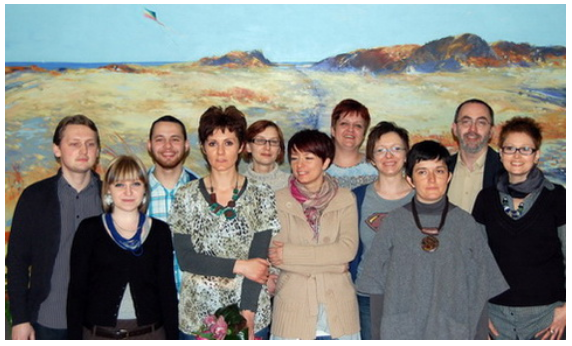
Furthermore, the area of interest for Prof. Widlak’s team included the molecular mechanisms of cellular responses to stress factors, including cellular responses to ionizing radiation. The conducted research was aimed at characterizing the interdependence between signal transduction pathways dependent on HFS1, NF- κB and p53 transcription factors. This research topic was conducted in collaboration with biomathematicians from the Silesian University of Technology in Gliwice (team of Prof. Andrzej Świerniak) and Rice University in Houston (team of Prof. Marek Kimmel). The work was the basis for the doctoral theses of Katarzyna Szołtysek (2012) and Patrick Janus (2013). Another topic of conducted research was the cardiotoxic effects of ionizing radiation. This research was initiated within the framework of cooperation with the European CARDIORISK consortium, and the obtained results were the basis of the doctoral theses of Karol Jelonek (2011) and Anna Walaszczyk (2014).
Currently, the team’s research interests also include the topic of exosomes as vesicles involved in biological signal transduction. This research was introduced by Prof. Monika Pietrowska and is carried out in cooperation with Prof. Theresa Whiteside (University of Pittsburgh, PA, USA). The conducted research was, among others, used in the doctoral theses of Agata Abramowicz (2019) and Mateusz Smolarz (2022).
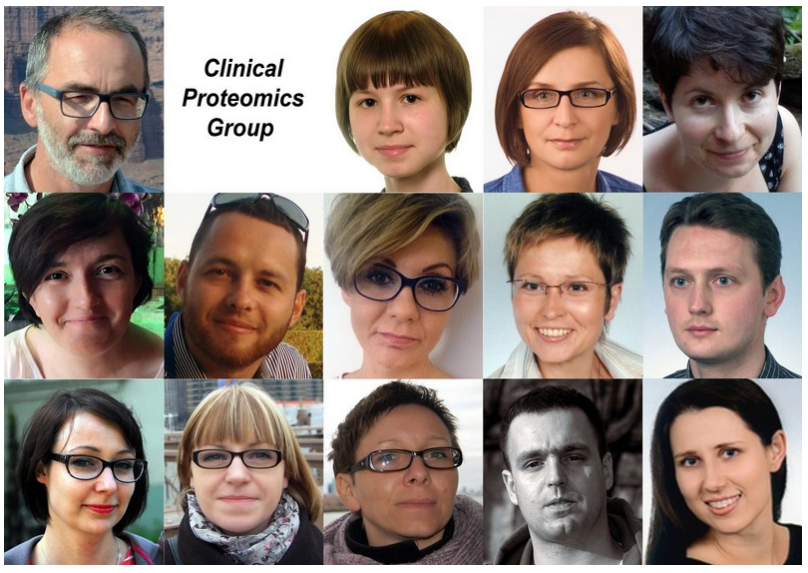
The Group of Clinical Proteomics takes care of the Mass Spectrometry Laboratory. The laboratory uses a number of research platforms (including MALDI-ToF MS, ESI-Orbitrap MS systems coupled with HPLC and NanoLC systems) enabling a wide range of proteomic research. The equipment was purchased as a part of the Silesian BIOFARMA investment project and a grant from the Ministry of Science and Higher Education for the establishment of a Laboratory for Research on the Structure and Function of Exosomes.
In our team’s research, we were concerned with characterizing the proteome of exosomes released in vitro by head and neck squamous cell carcinoma (HNSCC) cells with differential resistance to cisplatin, with the aim of identifying the components responsible for resistance to therapy. Our spectrum of interest also included characterizing the proteome of exosomes released in vitro by HNSCC cells responding differently to ionizing radiation. We conducted the research in international collaboration (the team of I. Tinhofer from Charite University in Berlin and the team of M.D. Story from UT Southwestern Medical Center in Dallas, USA). As a result of the research conducted using the infrastructure purchased under a grant from the Ministry of Science and Higher Education, we demonstrated the involvement of exosomes in induction of the bystander effect in recipient cells, i.e. the phenomenon resulting from the contact of irradiated cells with untreated cells.
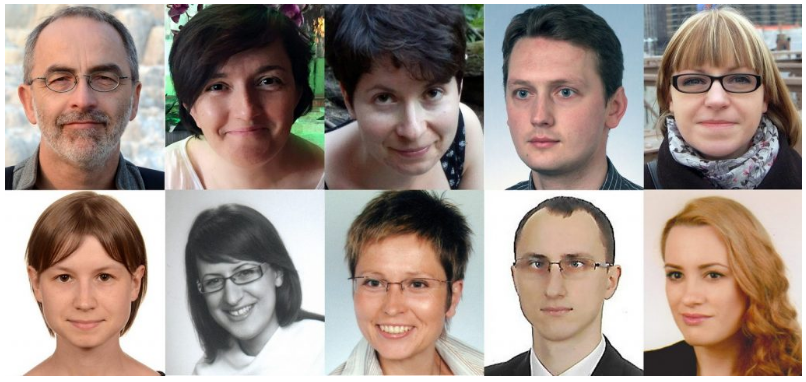
The Group of Clinical Proteomics also carried out projects on identification of molecules (mainly peptides) with different distributions in normal and pathological tissues (e.g., the search for markers of disease states). With “omics” methods, the strategy for identifying biomarkers at the tissue level is to compare the complete molecular profile (e.g., proteome) of a pathologically altered tissue (e.g., a cancerous tumor) and the corresponding normal tissue to find factors with significantly altered quantitative levels. Thanks to the advantages of the technique of molecular imaging of tissues using mass spectrometry (MALDI-ToF-MSI), it is possible to analyze and compare the molecular profile of the so-called regions of interest (ROI) defined by a pathologist in the microscope preparation without having to physically extract them by microdissection methods (so-called virtual microdissection). An important feature of MSI is the ability to directly assign the recorded molecular profiles to specific structures and cell types (precancerous cells, inflammatory areas, cells from the microenvironment, etc.). However, the truly unique feature of MSI is the ability to detect molecular dissimilarity between areas that do not show differences in the morphological microscopic image. Thus, the MSI method can detect and analyze molecular heterogeneity in tissue. Research on this topic has been developed by Dr. Marta Gawin under the supervision of Prof. Piotr Widlak.
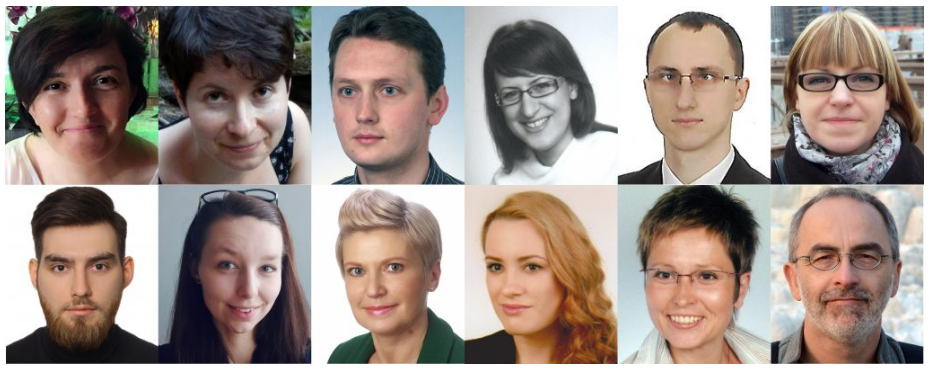
In the study of cancer biology, increasing attention is being paid to intercellular communication between tumor cells and normal cells (with particular emphasis on immune cells), which is mediated by extracellular vesicles. One of the functions attributed to small extracellular vesicles is to suppress the immune response in response to the developing tumor. Small extracellular vesicles can promote its development by transferring signaling molecules between cells, modulating the tumor microenvironment. The research we are currently conducting is aimed at evaluation of the protein profile of small extracellular vesicles released by melanoma (MTEX) cells. Our analysis to date of the signature of MTEX peptides isolated from the plasma of patients with metastatic melanoma has shown that PDCD6IP is the protein the level of which most strongly distinguishes patients with disease progression after cancer therapy (progressive disease, PD) from those with stable disease or no evidence of disease progression (no evidence of disease/stable disease, NED/SD). We are currently continuing to study the role of PDC6IP protein in melanoma progression. The project is carried out in international collaboration (T. Whiteside’s team from the University of Pittsburgh Cancer Institute, Pittsburgh, USA).
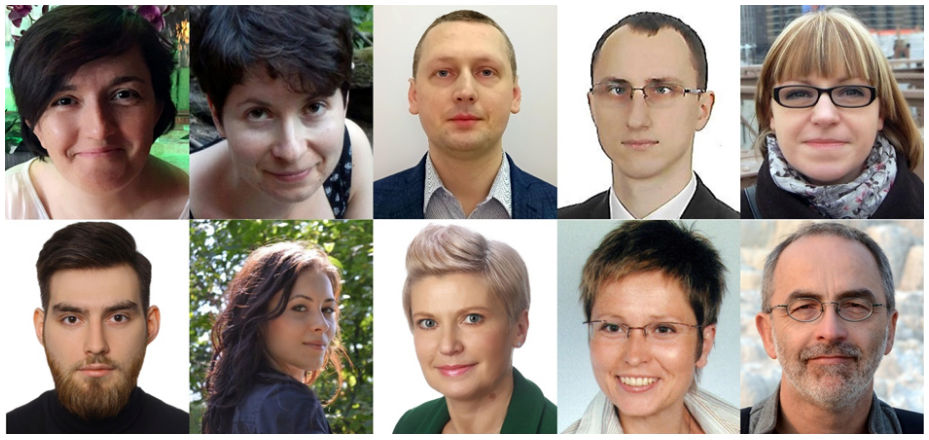
The presence of a number of parent cell-specific factors has been confirmed in the membrane of small extracellular vesicles, including key receptors to the immune response. Importantly, the major histocompatibility complex (MHC) profile present in the membrane of small extracellular vesicles is identical to the MHC profile of the parental cell. We assume that after kidney transplantation, both small extracellular vesicles with the recipient’s MHC profile and those released by the cells of the transplanted organ, i.e. by cells having the donor’s MHC profile, are present in the recipient’s bloodstream. The main cause of transplant rejection is the alloimmune response, which is initiated in the recipient’s secondary lymphoid organs by T cells that recognize the donor’s MHC antigens (allorecognition).
We hypothesize that allogeneic transplants release small extracellular vesicles that migrate from the graft and carry donor MHC molecules to the recipient’s lymphoid organs contributing to enhancement of the recipient’s immune response against the transplanted organ, resulting in rejection. In our current project, we plan to identify and analyze the composition and function of small extracellular vesicles released by cells of the transplanted organ and present in the recipient’s bloodstream. Quantitative monitoring of immunologically relevant antigens on the surface of small extracellular vesicles will contribute to the understanding of the immunomodulatory role of selected protein components of small extracellular vesicles and will expand the knowledge of the biology of these structures, with particular emphasis on their involvement in the mechanisms of rejection of the transplanted kidney. The ability to quantify the level of components specific to small extracellular vesicles released by the transplanted organ may in the future serve as a non-invasive method of monitoring the organ’s condition after transplantation and predicting the risk of graft rejection. The project is carried out in collaboration with the Medical University of Gdansk (Project Leader) and the Institute of Bioorganic Chemistry Polish Academy of Sciences in Poznan.

Marrow Donor Day event
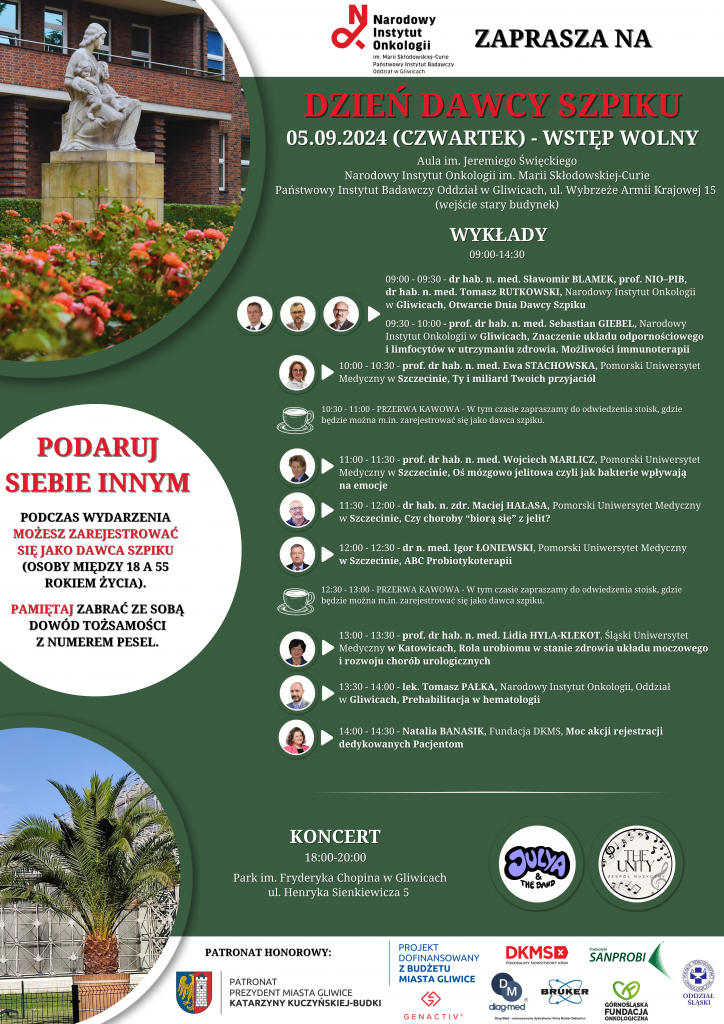
A few words about the history of the Marrow Donor Day event
For one young man with ambitious plans and big dreams, life wrote an unexpected and very difficult scenario. On March 21, 2022, Łukasz – a doctoral student at the Maria Sklodowska-Curie National Research Institute of Oncology – received a diagnosis: acute lymphoblastic leukemia. It was necessary to start treatment immediately. His previously arranged life had to be rearranged… turned upside down… many plans and dreams pushed aside. Łukasz took up the fight for his health and life, and his loved ones with him.
The originator of the Marrow Donor Day and its conduct is the team of the Laboratory of Clinical Proteomics, i.e. colleagues of Łukasz. The goal is to support people who have experienced cancer and their families, with a special focus on bone marrow donation.
The event was first held on September 5 (Tuesday) 2023.
It was immediately decided that the day would not be a one-time event, but would continue every year – always on September 5.
Why September 5?
Łukasz began treatment shortly after receiving the diagnosis (March 2022). The therapy was difficult, but on September 5 he was given a great chance for recovery – a bone marrow transplant!
That’s why the Marrow Donor Day was assigned to this very day. On September 5, 2023, in addition to promoting bone marrow donation, we also wanted to celebrate the first transplant birthday of Łukasz.
Łukasz was a graduate of the Faculty of Pharmaceutical Sciences with the Division of Laboratory Medicine at the Medical University of Silesia in Katowice. He received his master’s degree in medical biotechnology in 2018, completing his thesis on structural studies of pheomelanin obtained from dihydroxyphenylalanine and isotopically labeled cysteine by pyrolytic gas chromatography coupled to tandem mass spectrometry technique at the Department of Instrumental Analysis. After graduation, Skoczylas, MSc, joined the Laboratory of Drug Monitoring of SCCS (the Silesian Center for Heart Diseases) in Zabrze, where he was responsible for performing quantitative analyses of immunosuppressive drugs by high-performance liquid chromatography coupled to tandem mass spectrometry for both transplant patients and patients with autoimmune diseases. As of October 2021, he was a doctoral student at the Joint Doctoral School of the Silesian University of Technology conducting research on the immunomodulatory properties of exosomes released by human papillomavirus (HPV)-dependent and -independent cancer cells of the head and neck region. His supervisor was Monika Pietrowska, Ph.D., D.Sc., Professor of MSCNRIO.
Preparations for the 1st Marrow Donor Day
This day was to be celebrated with Łukasz. There was a lot to look forward to… Progress in treatment, a successful bone marrow transplant and a gradual improvement in health gave high hopes that a better time was coming. Unfortunately, it didn’t last long. In December, during one of his follow-up visits, Łukasz received a second piece of bad news: leukemia relapse. Rearranging life again, changing plans, another attempt to fight for health and life requires a person to have tremendous strength, hope, perseverance, patience, support from loved ones… Trying to put life together from a million pieces didn’t stand a chance… and Łukasz learned of the third recurrence.
The course of the 1st Marrow Donor Day
September 5 (Tuesday) 2023 was not an easy one, as at the same time Łukasz was fighting for his health and life in the hospital room, and we attended lectures and tried to entertain at a concert. It was nevertheless a day filled with hope that a better time will come for Łukasz and his loved ones.
A program was planned for the event, which consisted of a lecture portion at the Maria Sklodowska-Curie National Research Institute of Oncology and a concert portion at the Chopin Park in Gliwice. The lectures were on the subject of bone marrow and organ donation and transplantation. The concert consisted of performances of two bands. The first one was Autentikos, which is co-founded by, among others, two doctors from the MSCNRIO Department of Bone Marrow Transplantation and Hematology-Oncology: Prof. Sebastian Giebel, MD, PhD, DSc, a lyricist and vocalist, and a guitar player Tomasz Czerw, MD, PhD, DSc.
https://autentikos.pl/o-zespole
The second to perform was Julya, a talented singer of the younger generation.
https://www.instagram.com/julya.music/
One could also take advantage of body composition analysis and dietician’s advice, learn breast self-examination, but MOST IMPORTANTLY one could register in the DKMS Foundation database as a potential Marrow Donor. Our Łukasz was not with us at the lectures and concert, but with the help of the staff of the IT Department and the Department of Promotion and Cooperation of MSCNRIO, he was able to remotely participate with us in the lectures.
Results from the 1st Marrow Donor Day
The event, organized on the initiative of the Prof. Mieczysław Chorąży Center for Translational Research and Molecular Biology of Cancer at the Maria Sklodowska-Curie Narional Research Institute of Oncology in Gliwice, in cooperation with the DKMS Foundation and the Upper Silesian Oncology Foundation, gathered more than 80 listeners and provided an opportunity to register in the database of potential marrow donors. Thanks to our action, there were 16 new people in this database. This is a contribution to the over 2 million registry of bone marrow and hematopoietic cell donors in Poland! In recognition of them and all those to whom the idea of donating biological material is dear, a concert was held in the Chopin Park in Gliwice, with an audience of over 200 people.
Introducing the poster for the 1st Marrow Donor Day
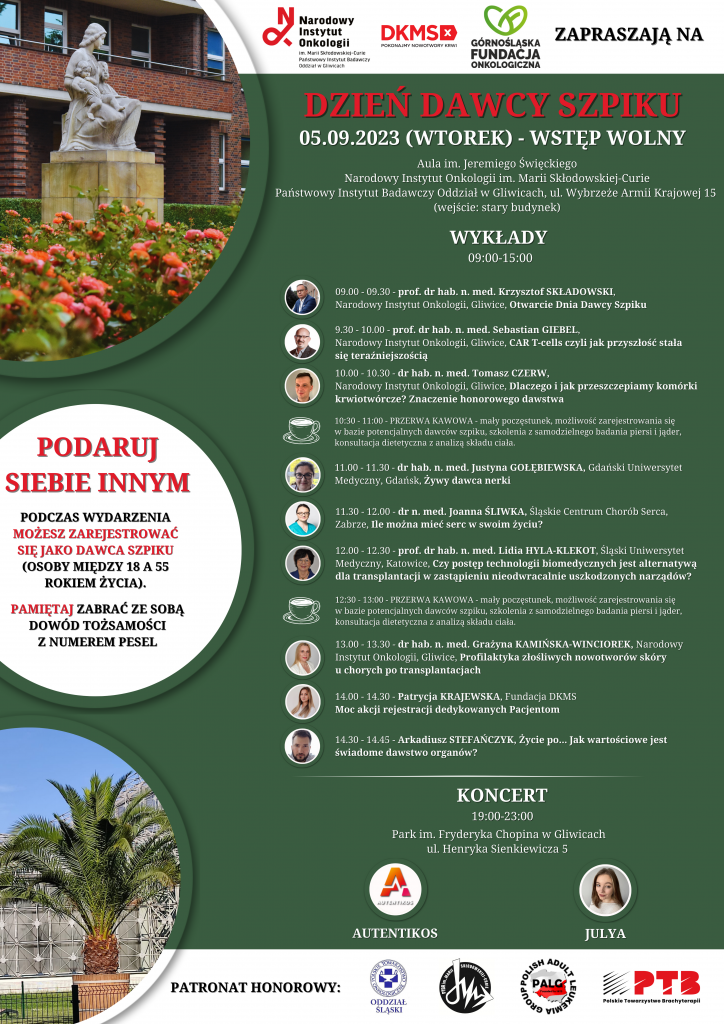
1st Marrow Donor Day Gallery
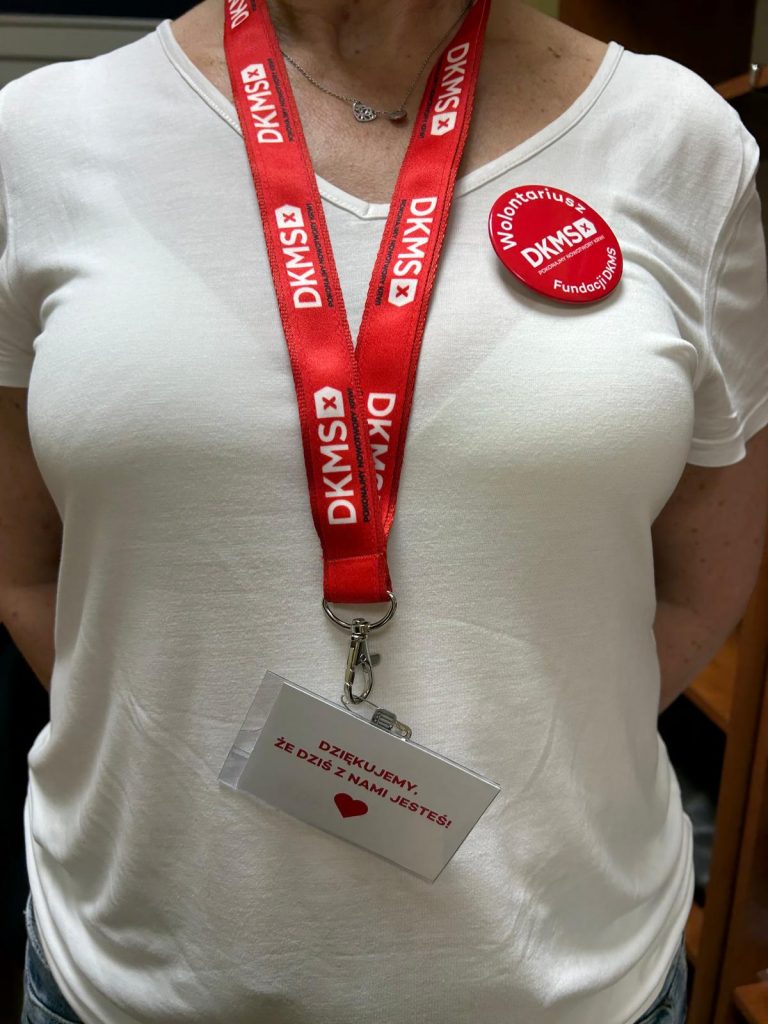
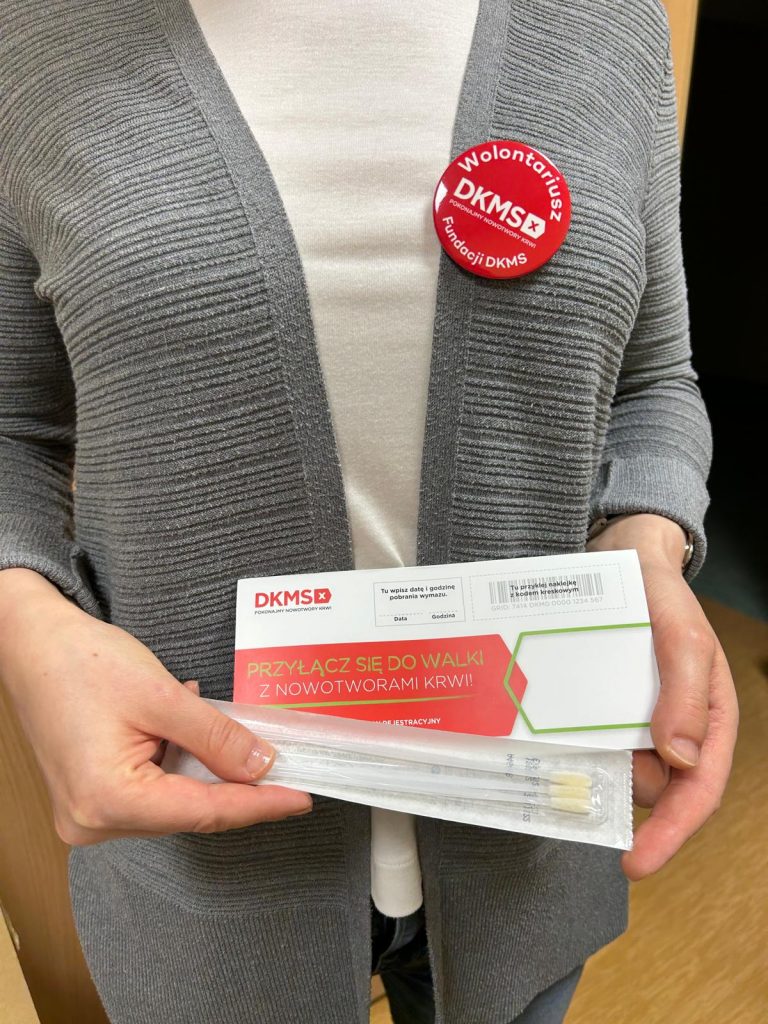

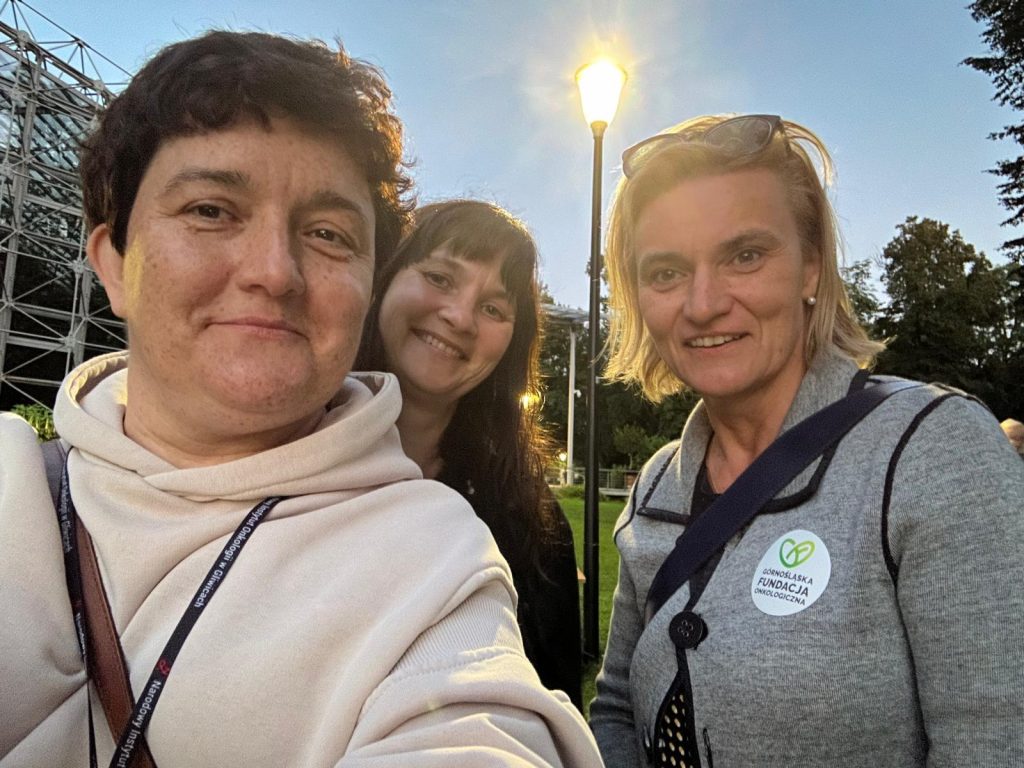
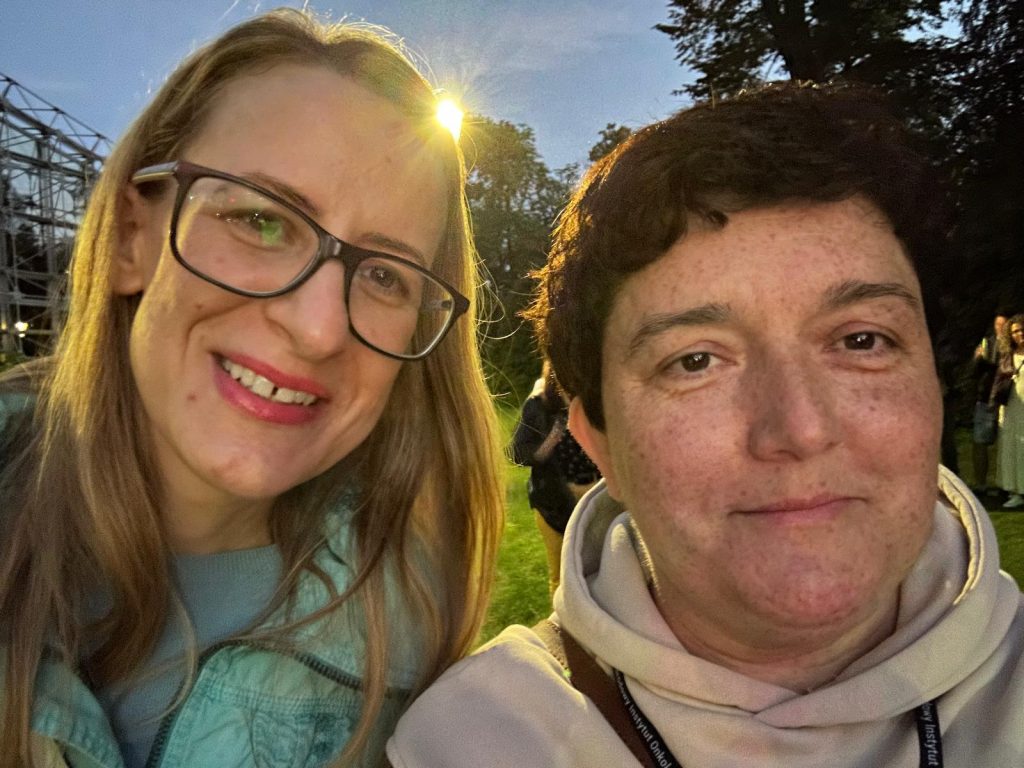
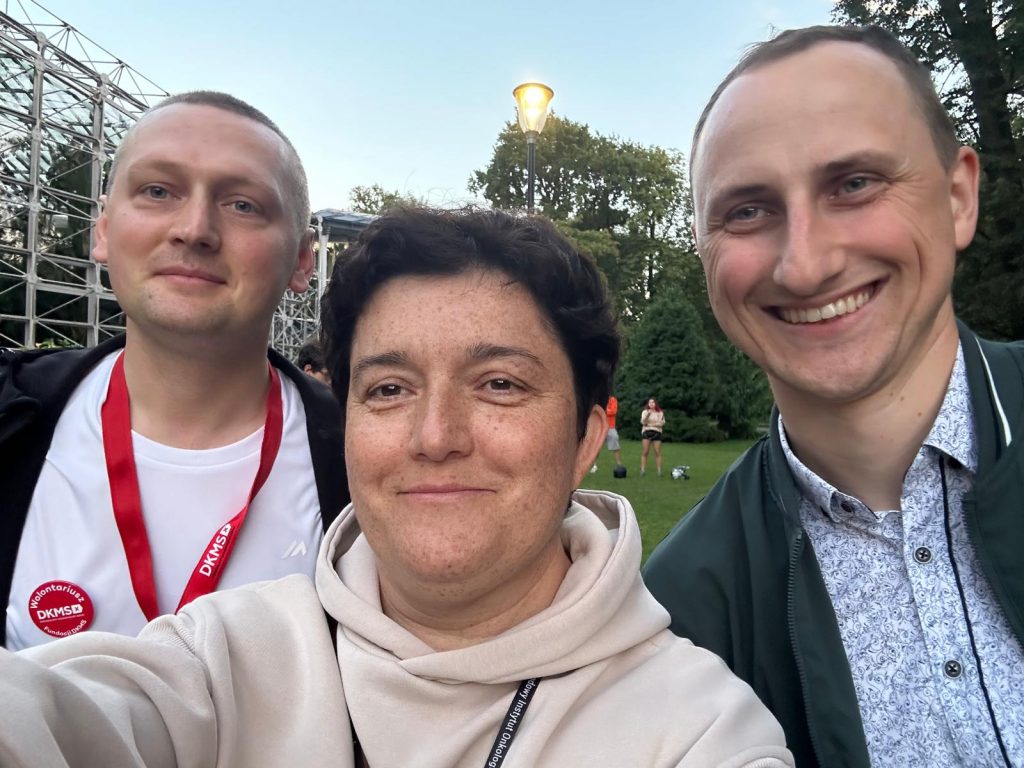

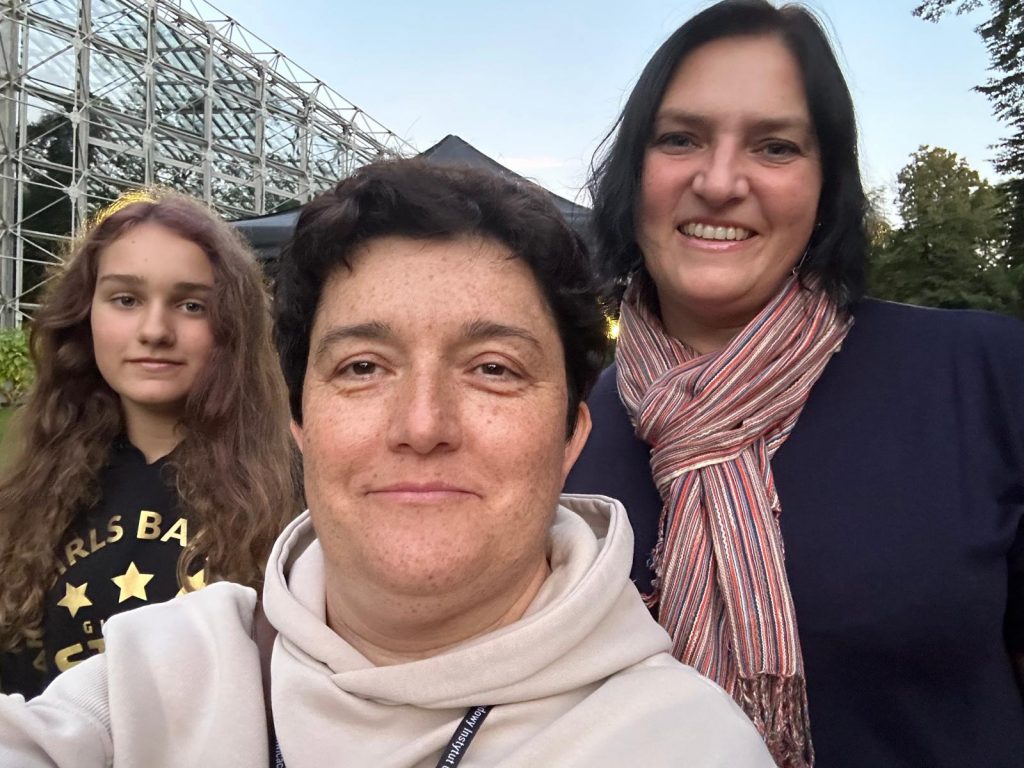

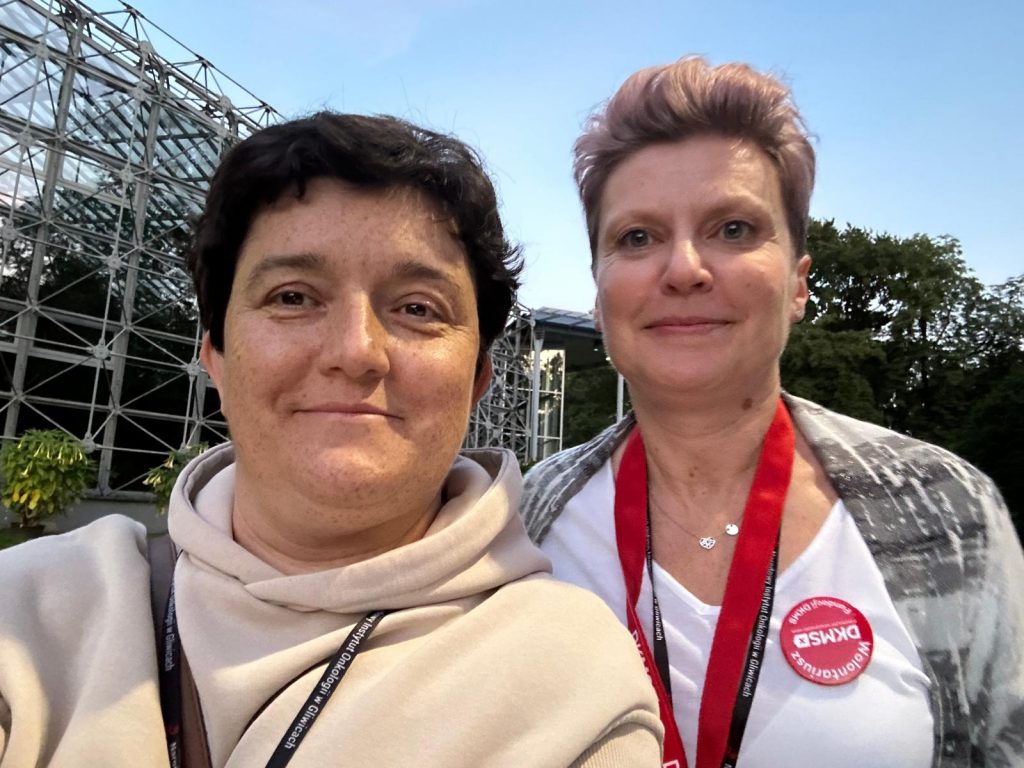

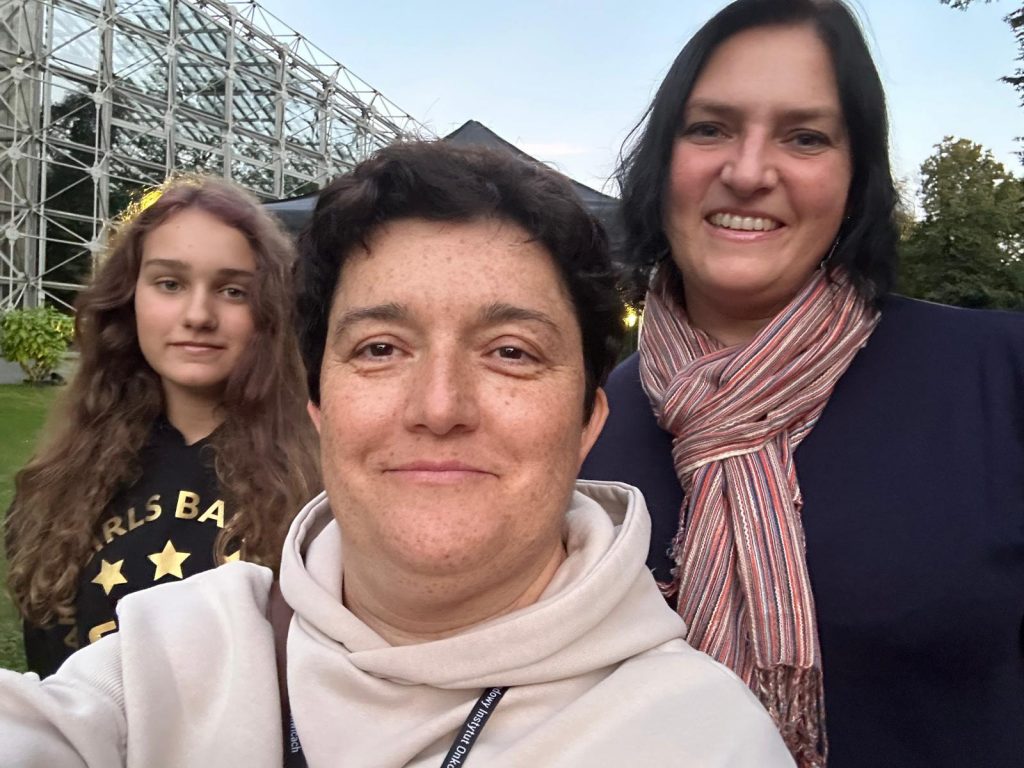
WE INVITE EVERYONE TO THE 2nd BONE MARROW DONOR DAY
Read on and realize how much good you can donate!!!
In Poland, every half an hour someone learns that they have a blood cancer, and globally – every half a minute or so! The chance of finding your genetic twin is 1 in 20 thousand! For patients with a rare genotype – even 1 in several million!
That’s why it’s so important to recruit new bone marrow and hematopoietic stem cell donors. We remind you of this especially in September – Blood Cancer Awareness Month.
On a daily basis, none of us think about people who are struggling with leukemia. Often we only begin to notice the tremendous struggle with this disease when someone close to us falls ill. Because of this, too, when we are not dealing with a leukemia patient, we forget how little effort is needed to help. All you have to do is decide to be a bone marrow donor and promote this to other people. It doesn’t hurt, it doesn’t consume much time, and we don’t pay any price for it! On the other hand, what the patient can gain – life and health… is priceless!
There is nothing more beautiful than giving someone health! Did you know that you may be the only chance to save someone’s life?
Unfortunately, we don’t know that it’s you if you are not registered in the DKMS database. That’s why it’s so important to come forward and register in the Marrow Donor Database. DKMS has been building a database of potential Marrow Donors for years – the more people registered in it, the greater the chances of finding a genetic twin.
Preparations for the 2nd Bone Marrow Donor Day
This year (2024), on Thursday, September 5, THE SECOND MARROW DONOR DAY will take place.
This would be the second transplant birthday for Łukasz… He is no longer with us.
It will be a difficult day for us, but we would like to convey hope, support and strength to all others struggling with cancer. Łukasz would like that too!
[Below is the text written for DKMS by Łukasz]
The disease can happen to any of us.

My name is Łukasz, I was born in Czestochowa and I am 27 years old. Despite knowing the risk factors leading to the development of various types of cancer and avoiding them through a healthy, active lifestyle and regular examinations, I have not been able to avoid the disease. The blood cancer I suffer from can happen to anyone regardless of lifestyle or age, and the fight against it is possible thanks to the support of genetic twins.
Last year, I started working on realizing my dream of working in science. Ironically, I was doing a project at the Maria Sklodowska-Curie National Research Institute of Oncology, related to new factors to help predict a patient’s response to cancer treatment. In no scenario of my future did I foresee what happened next. In March, due to increasing shortness of breath, fatigue and back pain that had been increasing for two weeks, I went to the laboratory for basic blood tests. The very next day, my family doctor was informed by the laboratory about the alarming number of lymphoblasts and I received a referral to the hematology outpatient clinic; after performing additional tests, it was decided to urgently admit me to the oncohematology department and start treatment for B-cell acute lymphoblastic leukemia. Since then, I have been a patient at the place where I appeared every day at work. This has changed my perspective and forced me from one day to the next to make changes that were previously out of my plans.
Treatment consists of several stages, which in turn include multiple and long stays in hospital. To effectively cure the cancer I suffer from, I need the help of a person who is my genetic twin. Registering on the DKMS database allows us to be matched and allows my twin to save my life.
Anyone who performs a painless and short-lasting cheek swab may turn out to be a genetic twin for me or another patient. In August next year, I planned to get married to my fiancée, who is my biggest supporter and really believes that my genetic twin will also help her dream of having her first dance with me at our wedding come true. Finding a suitable donor will allow me to return to work not only in the current remote form. After the transplant, I will personally conduct experiments in the laboratory, where my longing colleagues and my supervisor are waiting for me. Thank you all very much in advance for your help.


That is why registration in the Bone Marrow Donor database is so IMPORTANT. Take your loved ones with you, come, register and share your life. We also invite you to a series of lectures to be held at the Maria Sklodowska-Curie National Research Institute of Oncology and to an evening concert in the Chopin Park. The event is free of charge, and the lectures are conducted in an accessible way at a popular science level.
We encourage you to participate in the SECOND MARROW DONOR DAY